The Amigurumi Crochet Rhino is created with this crochet pattern in just a few steps. The crocheted rhino Piko prefers to doze in the afternoon sun. You can crochet the Amigurumi Rhino for decoration or as a cuddly toy.
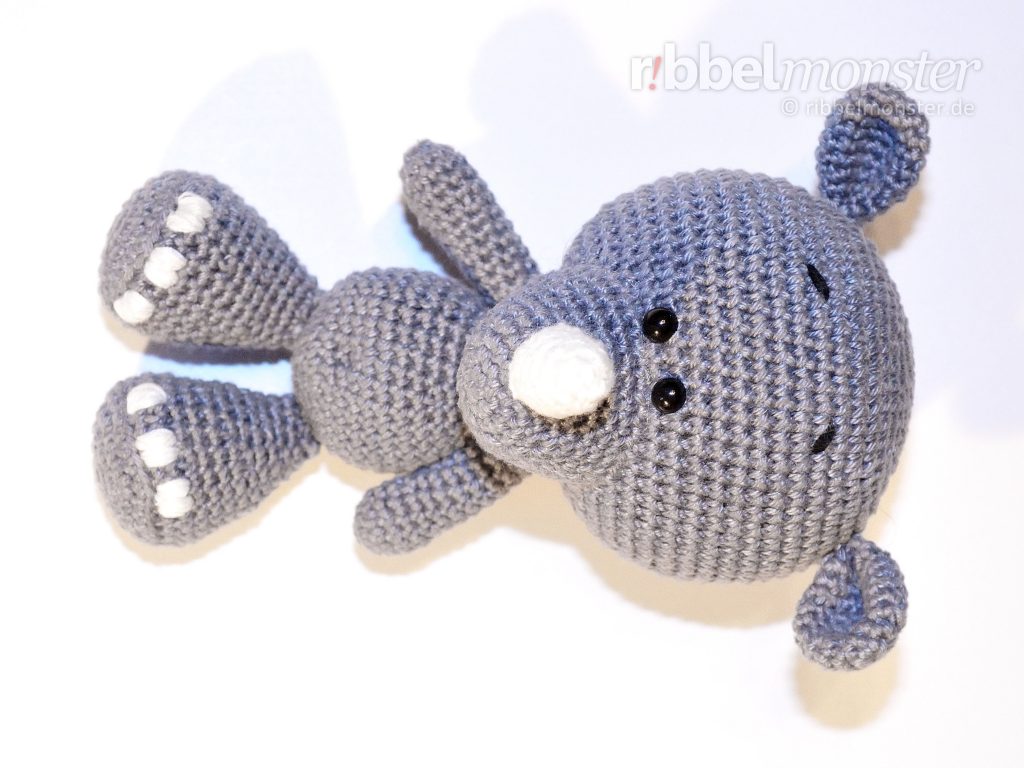
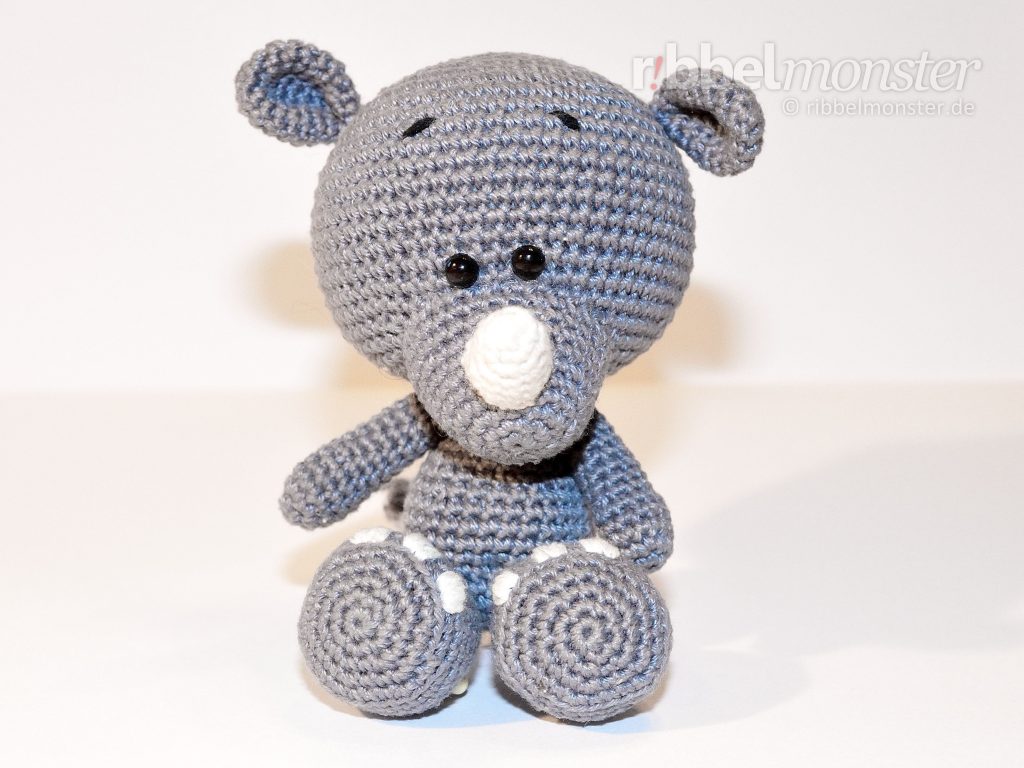
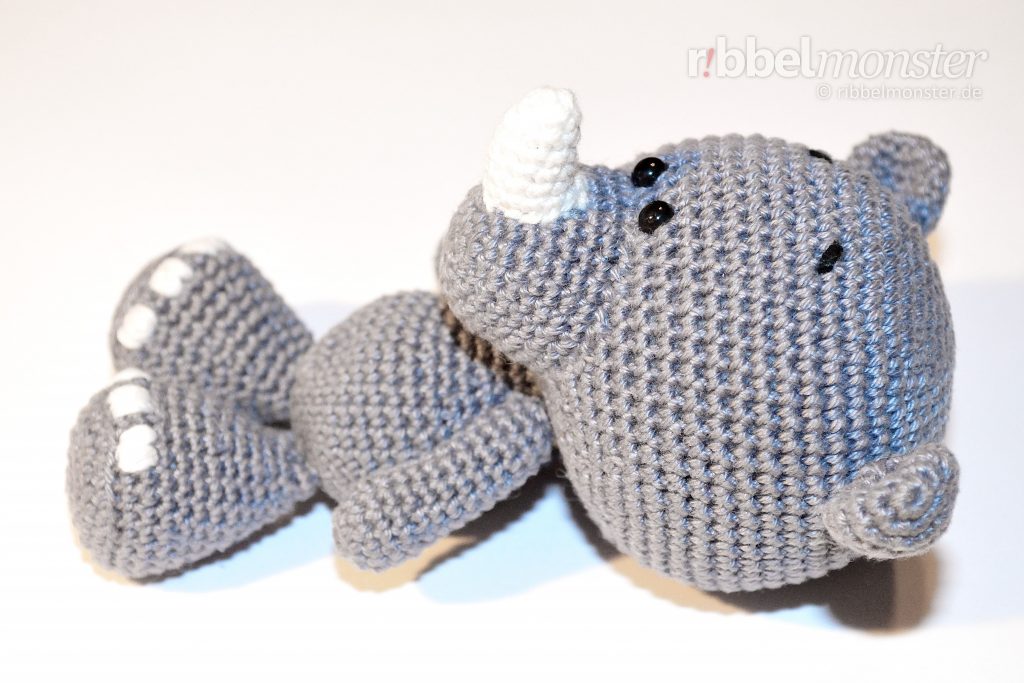
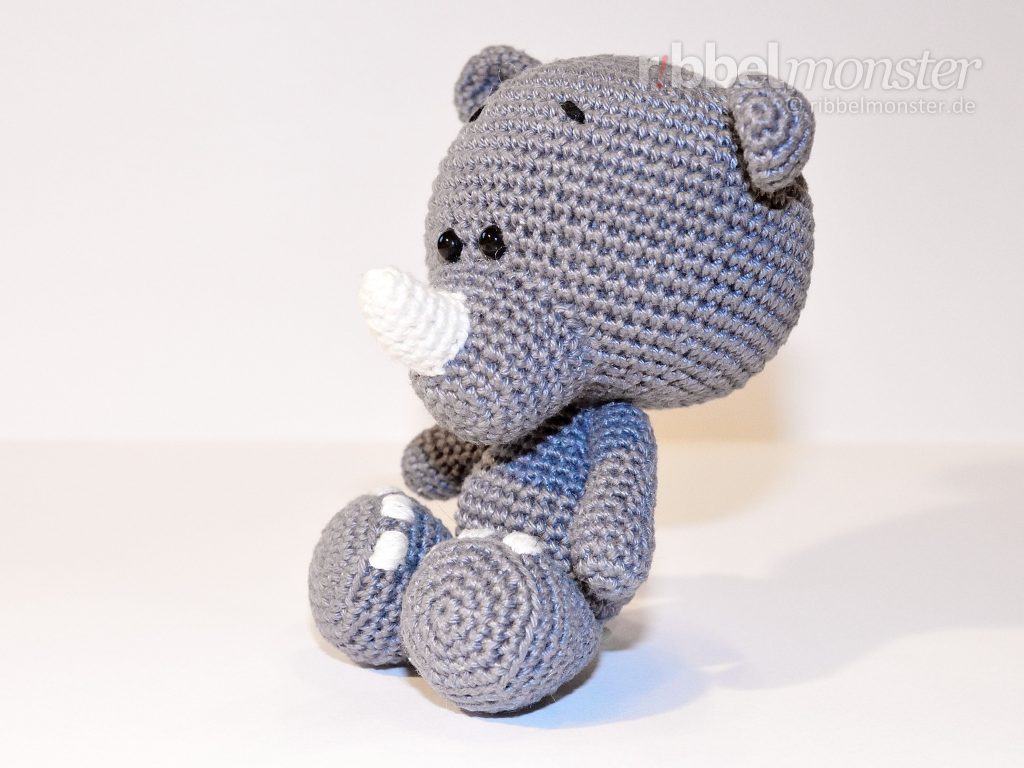
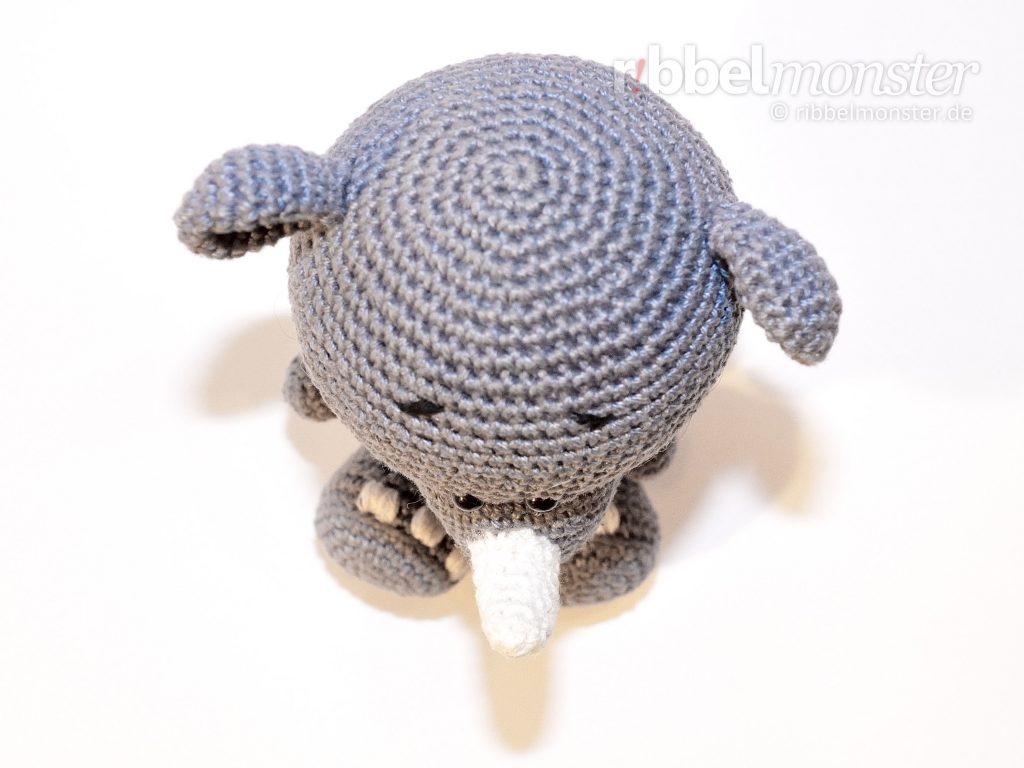
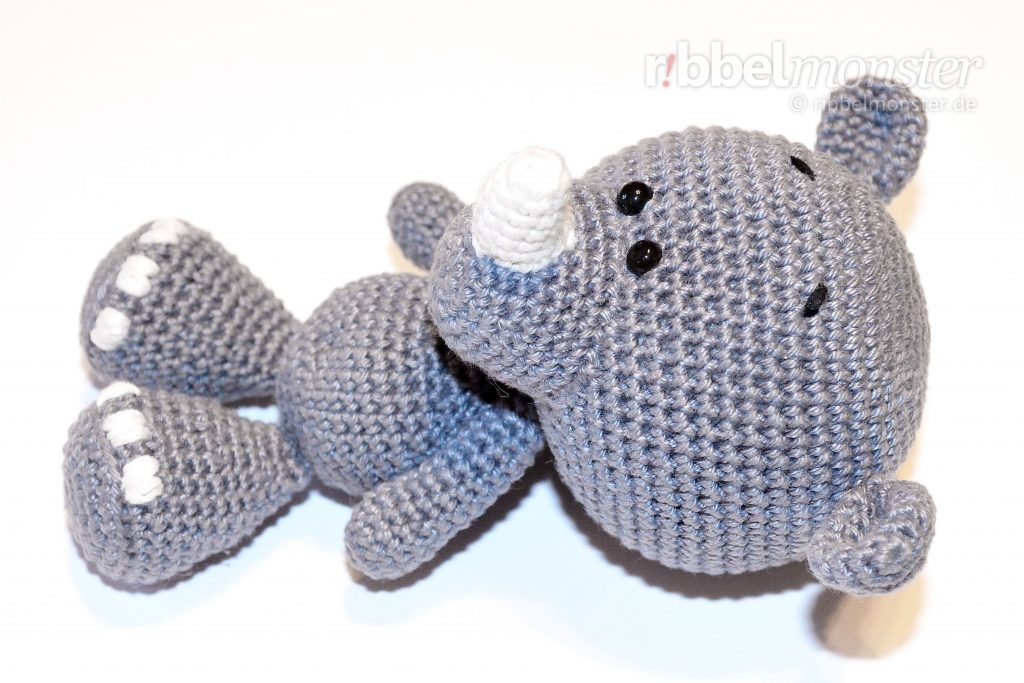
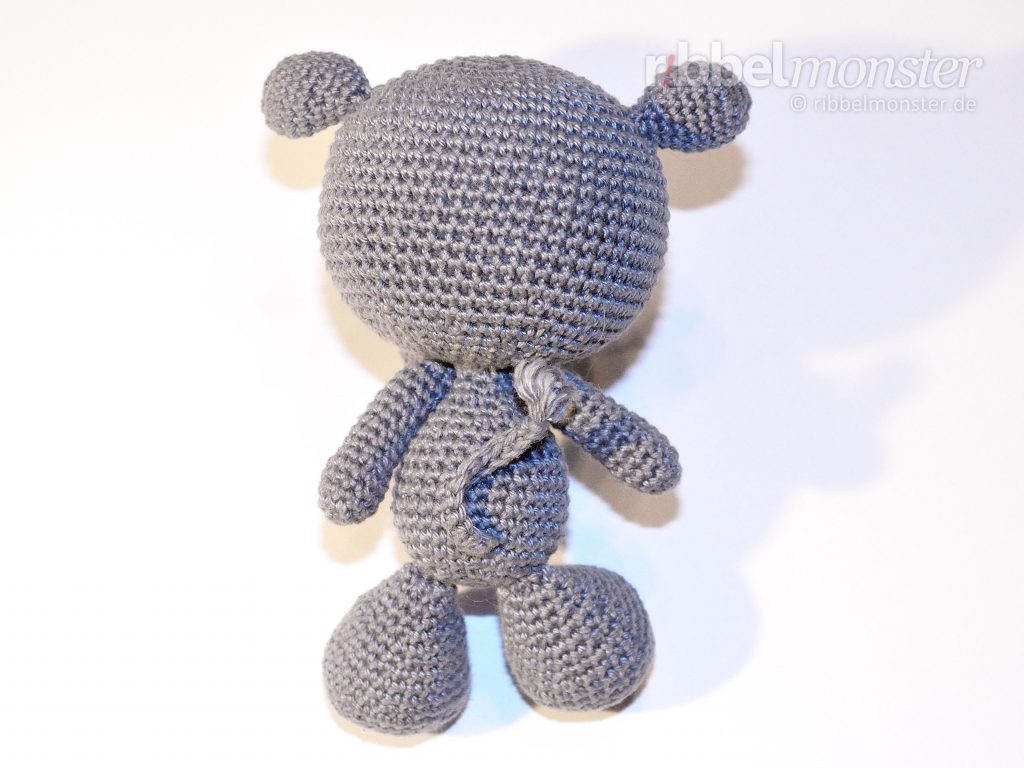
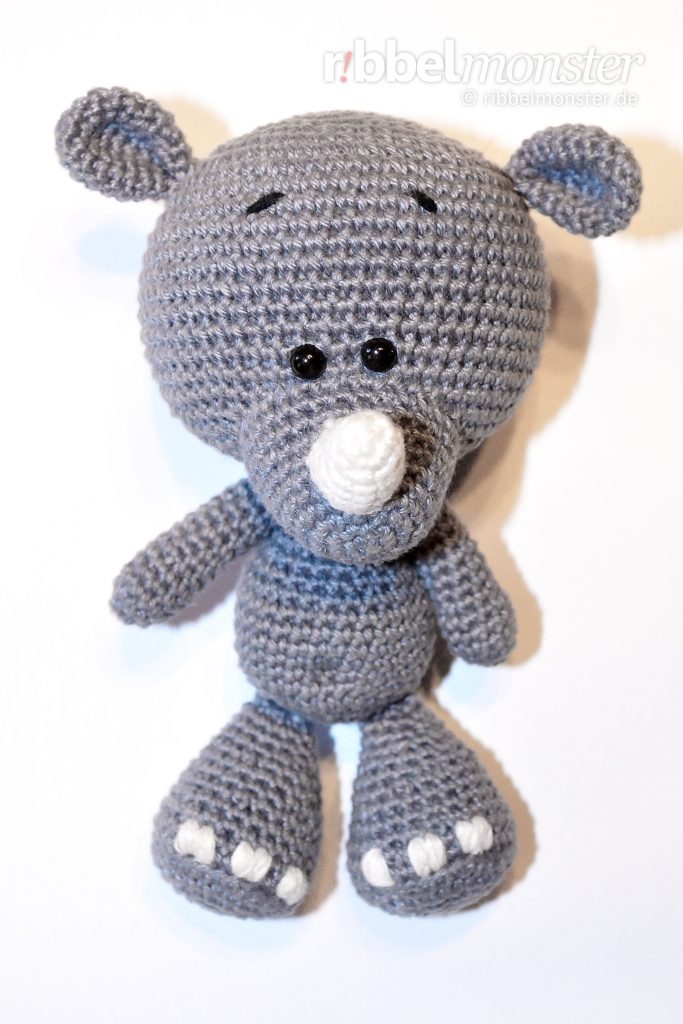
Content
Introduction: Amigurumi – Crochet Rhino “Piko”
Before crocheting the Amigurumi Rhino, some preparation is necessary. Here you will find all necessary information about prerequisites, materials, and size that you need. If you need help, you will find additional links in the respective sections.
Attention! Amigurumis are very cute and, therefore, not only popular among adults. Children often see them as toys, so you should be especially careful. Amigurumis that are not intended for play should be kept out of the reach of children. If an Amigurumi is meant to be played with by children, you should strictly adhere to the guidelines for toys. If you plan to give away or sell Amigurumis (license for sellers), you must strictly adhere to the legal requirements for toys and display the required CE marking.
Prerequisites
To implement this crochet pattern for an Amigurumi Rhino effortlessly, you should already be familiar with the following crochet techniques. You will find a detailed tutorial for each technique here so that you can quickly learn them yourself.
- Chain Stitches
- Decreases
- Double Crochet Stitches (UK!)
- Increases
- Loops of a Stitch
- Magic Ring
- Slip Stitches
- Spiral Rounds
- Turning Chain Stitches
Note! By offsetting regular increases and decreases, they become almost invisible. You can recognize regular increases by the phrase “double every … stitch,” and regular decreases by the phrase “crochet together every … and … stitch”. The stitch chart for spheres and circles might also be helpful for you.
Note! Using a special technique for invisible decreases makes them nearly invisible. Although this technique requires a bit of practice, it’s worth giving it a try.
Supplies
To crochet the depicted Amigurumi Rhino, the following materials were used. The Amigurumi Rhino can be crocheted with any yarn and the corresponding needle size. To achieve an authentic result, you should use exactly the listed materials. In addition to the materials, you will also find a list of the necessary tools and supplies here.
Crochet Hook
You will need a crochet hook with a size of 12 (british). For converting to other sizes, the crochet hook size converter will help you. I have selected some great crochet hooks for you here.
Darning Yarn
I have used darning yarn in the shade of black here. If you cannot find a suitable darning yarn in your supplies, I have already selected some for you.
Darning Yarn
I used stuffing yarn in the shade of White here. If you can’t find suitable stuffing yarn in your supplies, I’ve already picked out some for you.
Filling
For filling, I used synthetic filling made of 100% polyester. However, there are numerous alternatives for filling material. If you’ve run out of filling, I’ve prepared a refill for you here.
Pins
You’ll also need a few pins. The more colorful your collection, the better. If you need more, I’ve found something for you.
Safety Eyes
I used 2 safety eyes with a diameter of 1/4 inches. The eyes are completely black. However, there are countless alternatives for amigurumi eyes. You might prefer other safety eyes as well.
Scissors – any
You’ll need any scissors. It’s best to use your most beautiful scissors because it brings you joy. If you don’t have really nice scissors, I’ve picked out some lovely ones for you.
Wool Needle
You’ll need a wool needle with a blunt tip. The thickness of the wool needle should match the thickness of your yarn. You might like the set of wool needles I’ve picked out for you.
Yarn – Schachenmayr – Catania – 106 – weiß
I used yarn in the shade White. The material is 100% cotton. The yardage is 137 yds / 1.75 oz. If you want to replenish your supply, I’ve already picked out the matching yarn for you here.
Yarn – Schachenmayr – Catania – 269 – graublau
I used yarn in the shade Grey Blue. The material is 100% cotton. The yardage is 137 yds / 1.75 oz. If you want to replenish your supply, I’ve already picked out the matching yarn for you here.
Note! I have used safety eyes here. If you have never attached safety eyes before, you can also find detailed instructions on how to attach safety eyes here. In addition to a wide selection of other safety eyes, there are also numerous alternatives for amigurumi eyes. Simply use the eyes that you like best.
Note! The specified yarn was used for the example shown here. In principle, you can use any yarn and an appropriate needle size. However, the quality of the material also affects the quality of the result, so you should avoid cutting corners in the wrong place. Also, the thickness of the yarn and the needle will influence the size of the outcome, which you can, of course, intentionally take advantage of.
Size
Here are the size specifications for the crocheted Amigurumi Rhino. The height was measured standing without ears. Please note that the actual size depends on the yarn used, the size of the crochet hook, and individual crochet tension.
| Needle Size | Yardage | Size |
|---|---|---|
| Crochet Hook 12 | 137 yds / 1.75 oz | 6 1/5 inch |
| Crochet Hook 11 | 120 yds / 1.75 oz | ? |
| Crochet Hook 9 or 10 | 93 yds / 1.75 oz | ? |
Note! If you want to change the size, you can simply use a thicker or thinner yarn with a suitable needle size. Simply doubling the rounds, rows, and stitches, on the other hand, will only result in an uneven outcome.
Crochet Pattern: Amigurumi – Crochet Rhino “Piko”
For the Amigurumi Crochet Rhino, we first crochet the head and body, and then the arms, legs, snout, horn, tail, and ears. After that, all parts are sewn together, individual parts are shaped, and embroideries are applied.
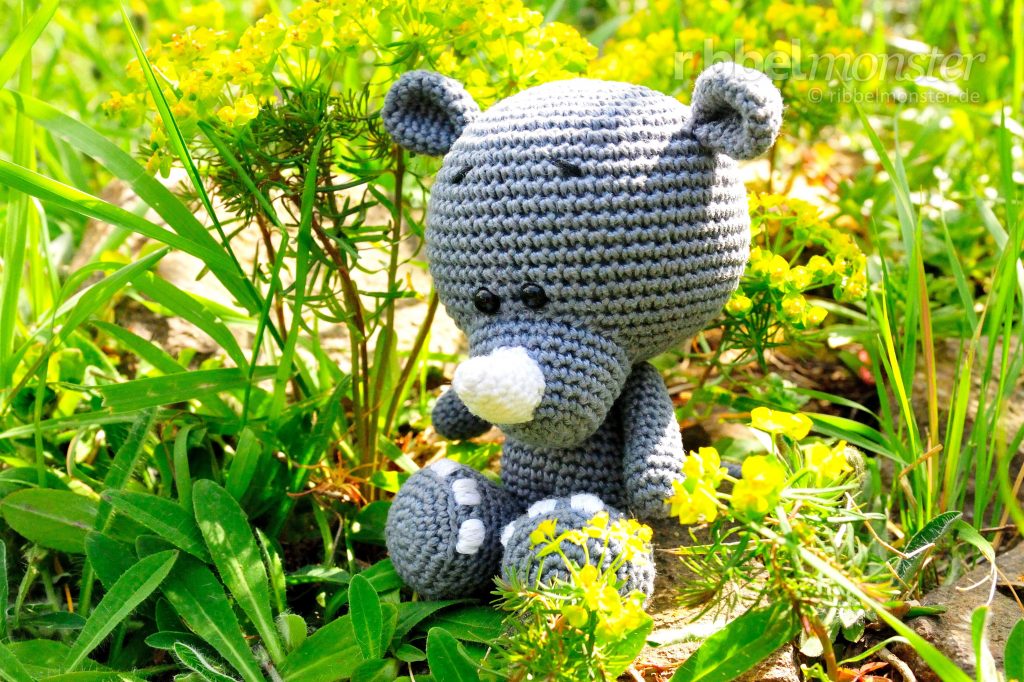
But even if it sounds very complicated now, it’s not too difficult. Just follow all the instructions and pictures! If you ever don’t know what to do, you can always reach out to us through the comment function.
Head for Crochet Rhino (1x)
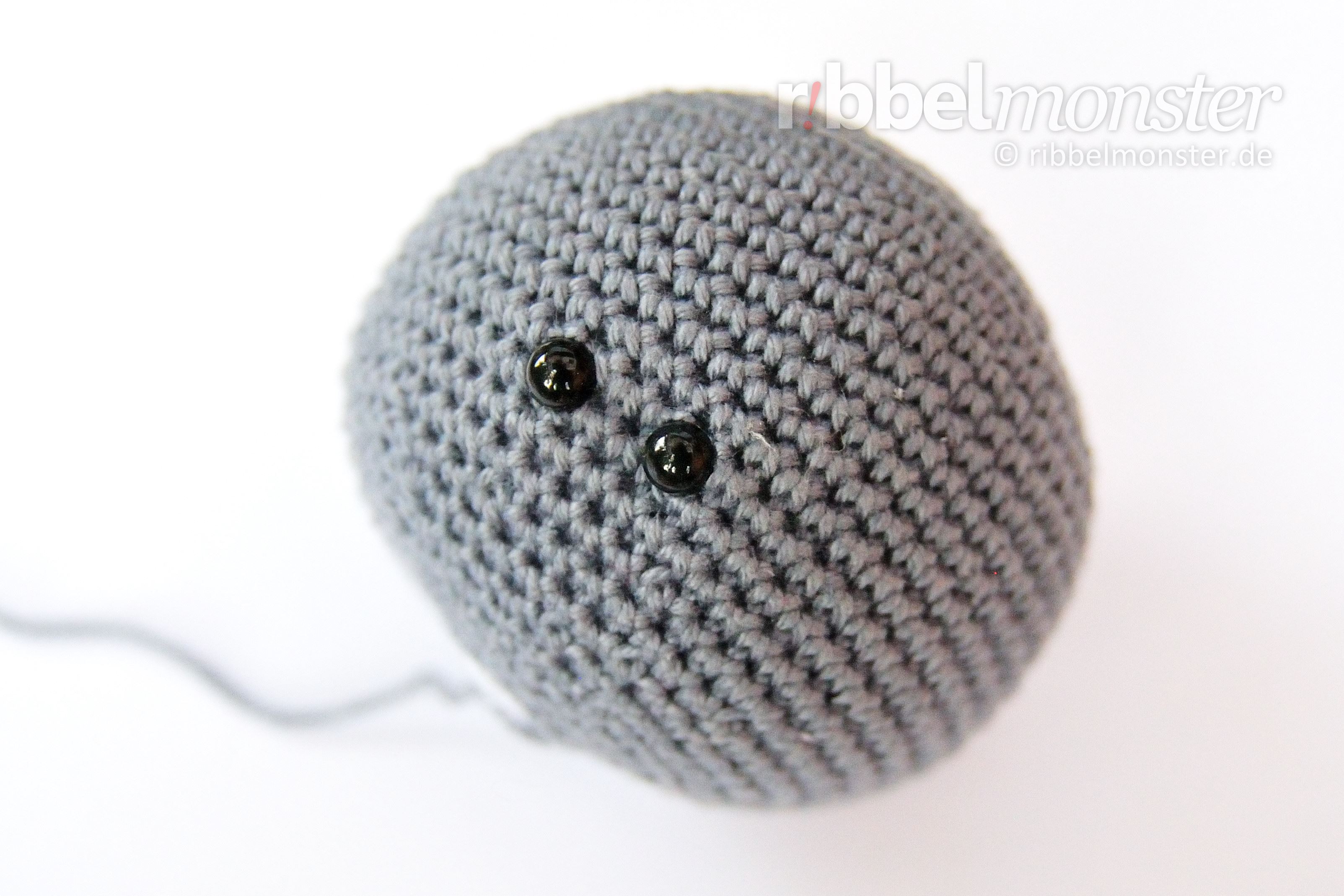
The head for the Crochet Rhino is worked from top to bottom in spiral rounds using only double crochet stitches (UK!). The head is filled and stuffed neatly. The remaining yarn end will be needed later to sew the head all around to a body.
Note! If you want to achieve a particularly beautiful result, you can hide regular increases and decreases by offsetting them a little. You can recognize regular increases by the phrase “double every … stitch,” and regular decreases by the phrase “crochet together every … and … stitch”. The stitch chart for spheres and circles might also be helpful for you. Additionally, you can apply a special crochet technique here for invisible decreases.
- grey:
- 1st round:
- magic ring
- into the magic ring:
- 6 double crochet stitches (UK!)
- = 6 stitches
- 2nd round:
- double every stitch
- = 12 stitches
- 3rd round:
- double every 2nd stitch
- = 18 stitches
- 4th round:
- double every 3rd stitch
- = 24 stitches
- 5th round:
- double every 4th stitch
- = 30 stitches
- 6th round:
- double every 5th stitch
- = 36 stitches
- 7th round:
- double every 6th stitch
- = 42 stitches
- 8th round:
- double every 7th stitch
- = 48 stitches
- 9th round:
- double every 8th stitch
- = 54 stitches
- 10th round:
- double every 9th stitch
- = 60 stitches
- 11th – 21st round:
- (= 11 rounds)
- every stitch one stitch
- = 60 stitches
- attach safety eyes, position:
- after the 19th round
- 2 stitches distance
- 22nd round:
- crochet together every 9th and 10th stitch
- = 54 stitches
- 23rd round:
- crochet together every 8th and 9th stitch
- = 48 stitches
- 24th round:
- crochet together every 7th and 8th stitch
- = 42 stitches
- 25th round:
- crochet together every 6th and 7th stitch
- = 36 stitches
- 26th round:
- crochet together every 5th and 6th stitch
- = 30 stitches
- 27th round:
- crochet together every 4th and 5th stitch
- = 24 stitches
- 28th round:
- crochet together every 3rd and 4th stitch
- = 18 stitches
- fill and stuff completely
- 29th round:
- crochet together every 2nd and 3rd stitch
- = 12 stitches
- cut yarn generously, pull through loop, do NOT cut the yarn end, it will be used later for sewing
Body for Crochet Rhino (1x)
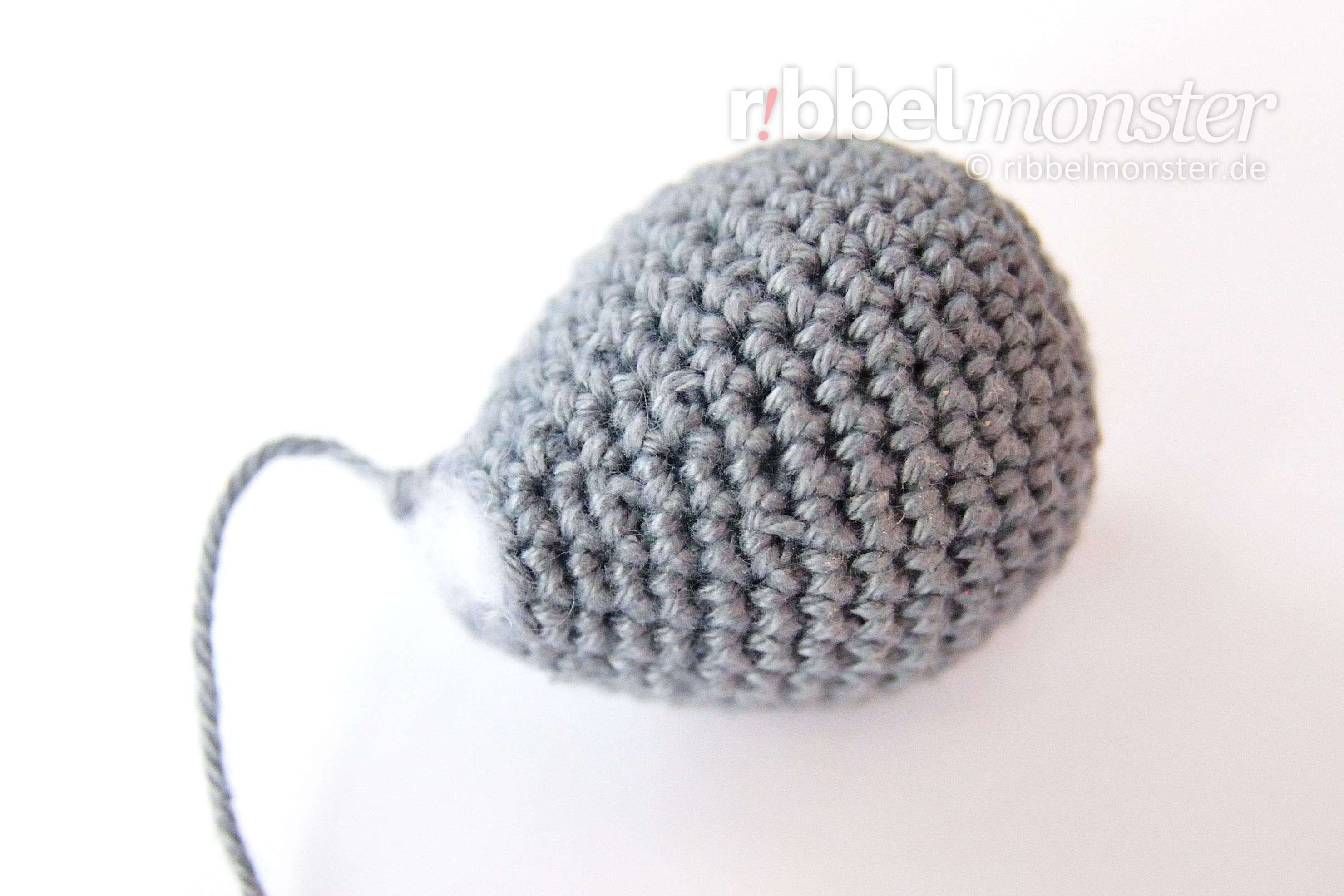
The body for the Crochet Rhino is worked from bottom to top with only double crochet stitches (UK!) in spiral rounds. The head and body will be sewn together with the openings facing each other.
Note! If you want to achieve a particularly beautiful result, you can hide regular increases and decreases by offsetting them a little. You can recognize regular increases by the phrase “double every … stitch,” and regular decreases by the phrase “crochet together every … and … stitch”. The stitch chart for spheres and circles might also be helpful for you. Additionally, you can apply a special crochet technique here for invisible decreases.
- grey:
- 1st round:
- magic ring
- into the magic ring:
- 6 double crochet stitches (UK!)
- = 6 stitches
- 2nd round:
- double every stitch
- = 12 stitches
- 3rd round:
- double every 2nd stitch
- = 18 stitches
- 4th round:
- double every 3rd stitch
- = 24 stitches
- 5th round:
- double every 4th stitch
- = 30 stitches
- 6th – 11th round:
- (= 6 rounds)
- every stitch one stitch
- = 30 stitches
- 12th round:
- crochet together every 9th and 10th stitch
- = 27 stitches
- 13th round:
- crochet together every 8th and 9th stitch
- = 24 stitches
- 14th round:
- crochet together every 7th and 8th stitch
- = 21 stitches
- 15th round:
- crochet together every 6th and 7th stitch
- = 18 stitches
- 16th round:
- crochet together every 5th and 6th stitch
- = 15 stitches
- 17th round:
- crochet together every 4th and 5th stitch
- = 12 stitches
- fill and stuff completely
- cut the thread, pull off the loop
Ears for Crochet Rhino (2x)
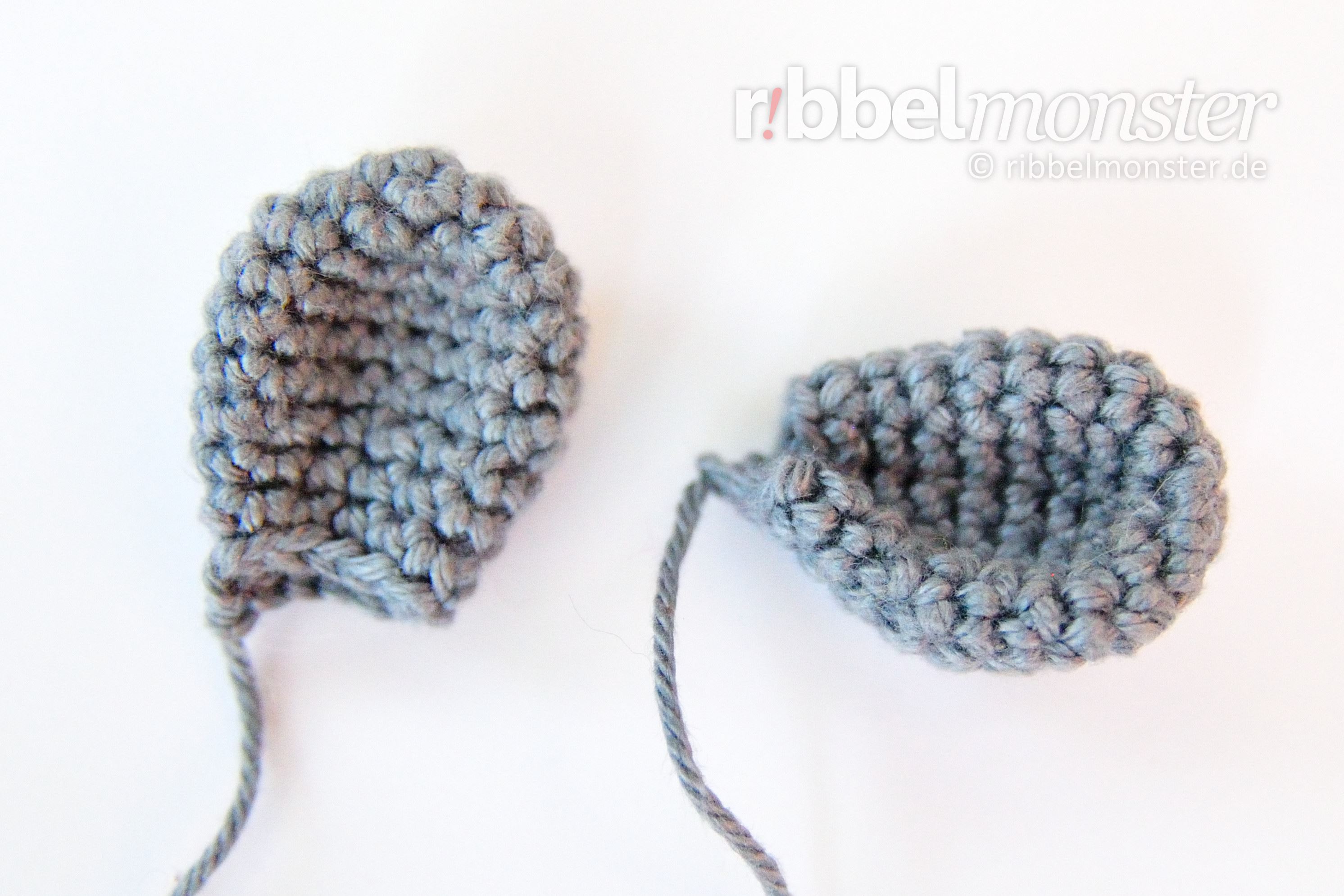
Next, we want to make the ears for the Crochet Rhino. We crochet the ears from top to bottom in spiral rounds. However, the ears are not filled so that they can be sewn flat with the yarn end to the head later.
Note! If you want to achieve a particularly beautiful result, you can hide regular increases and decreases by offsetting them a little. You can recognize regular increases by the phrase “double every … stitch,” and regular decreases by the phrase “crochet together every … and … stitch”. The stitch chart for spheres and circles might also be helpful for you. Additionally, you can apply a special crochet technique here for invisible decreases.
Note! If you want to create several nearly identical parts, it’s advisable to work on them consecutively on the same day. For larger parts, it’s even recommended to work on them simultaneously in stages. Our tension and tightness can vary from day to day, leading to visible differences.
- grey:
- 1st round:
- magic ring
- into the magic ring:
- 6 double crochet stitches (UK!)
- = 6 stitches
- 2nd round:
- double every stitch
- = 12 stitches
- 3rd round:
- double every 2nd stitch
- = 18 stitches
- 4th – 7th round:
- (= 4 rounds)
- every stitch one stitch
- = 18 stitches
- 8th round:
- crochet together every 2nd and 3rd stitch
- = 12 stitches
- 9th + 10th round:
- (= 2 rounds)
- every stitch one stitch
- = 12 stitches
- cut yarn generously, pull through loop, do NOT cut the yarn end, it will be used later for sewing
Snout for Crochet Rhino (1x)
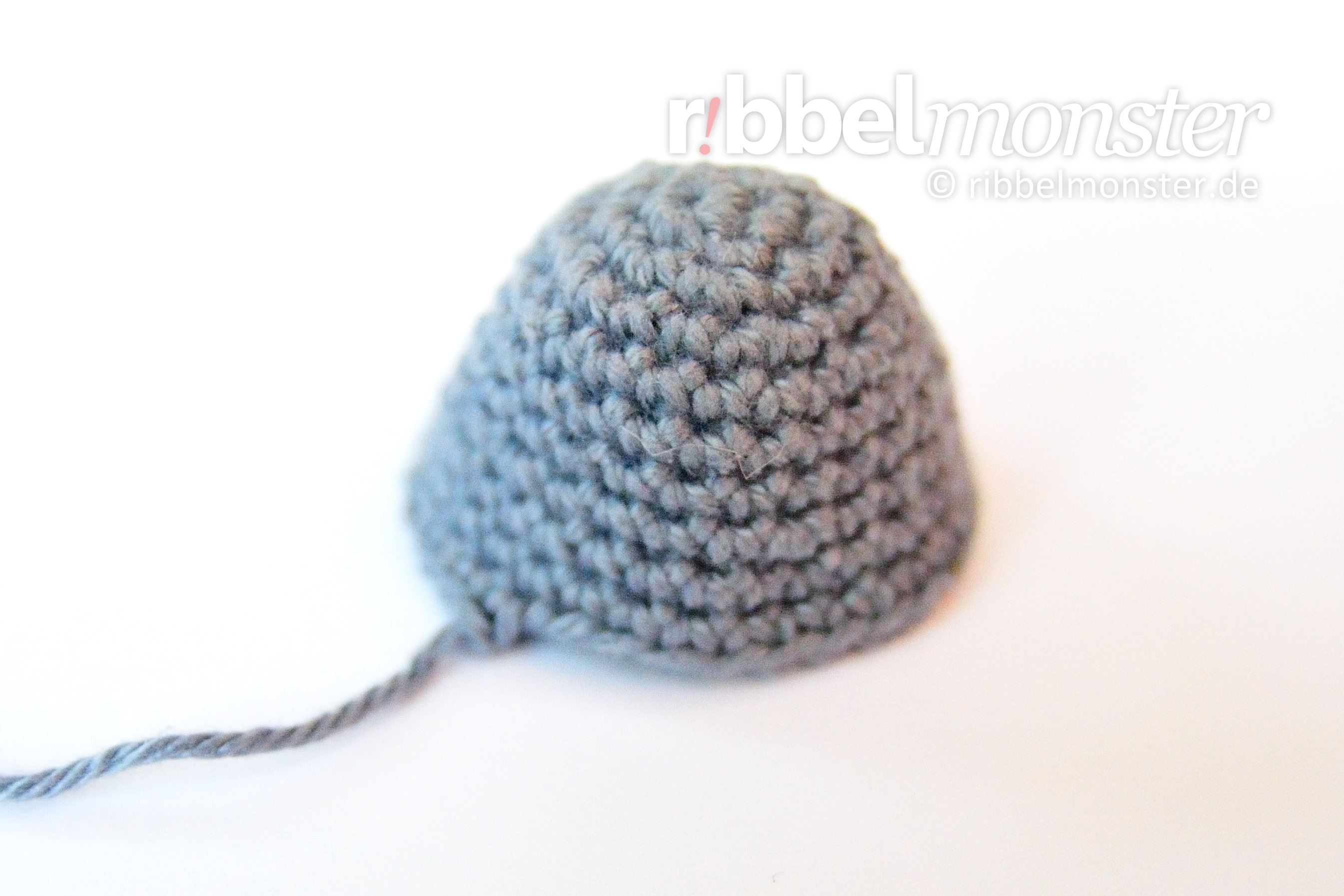
The snout for the Crochet Rhino is worked from the inside to the outside in spiral rounds using only double crochet stitches (UK!). The snout will later be sewn open around the head with the yarn end and filled during sewing.
Tip: Wenn du ein besonders schönes Ergebnis erhalten möchtest, kannst du die regelmäßigen Zunahmen durch Versetzen ein wenig verstecken. Dazu verwendest du einfach die Maschentabelle für Kugeln und Kreise.
(Redaktion: Block ersetzen)
- grey:
- 1st round:
- magic ring
- into the magic ring:
- 6 double crochet stitches (UK!)
- = 6 stitches
- 2nd round:
- double every stitch
- = 12 stitches
- 3rd round:
- double every 2nd stitch
- = 18 stitches
- 4th round:
- double every 9th stitch
- = 20 stitches
- 5th round:
- double every 10th stitch
- = 22 stitches
- 6th round:
- double every 11th stitch
- = 24 stitches
- 7th round:
- double every 12th stitch
- = 26 stitches
- 8th round:
- double every 13th stitch
- = 28 stitches
- 9th round:
- double every 14th stitch
- = 30 stitches
- 10th round:
- every stitch one stitch
- = 30 stitches
- cut yarn generously, pull through loop, do NOT cut the yarn end, it will be used later for sewing
Tail for Crochet Rhino (1x)
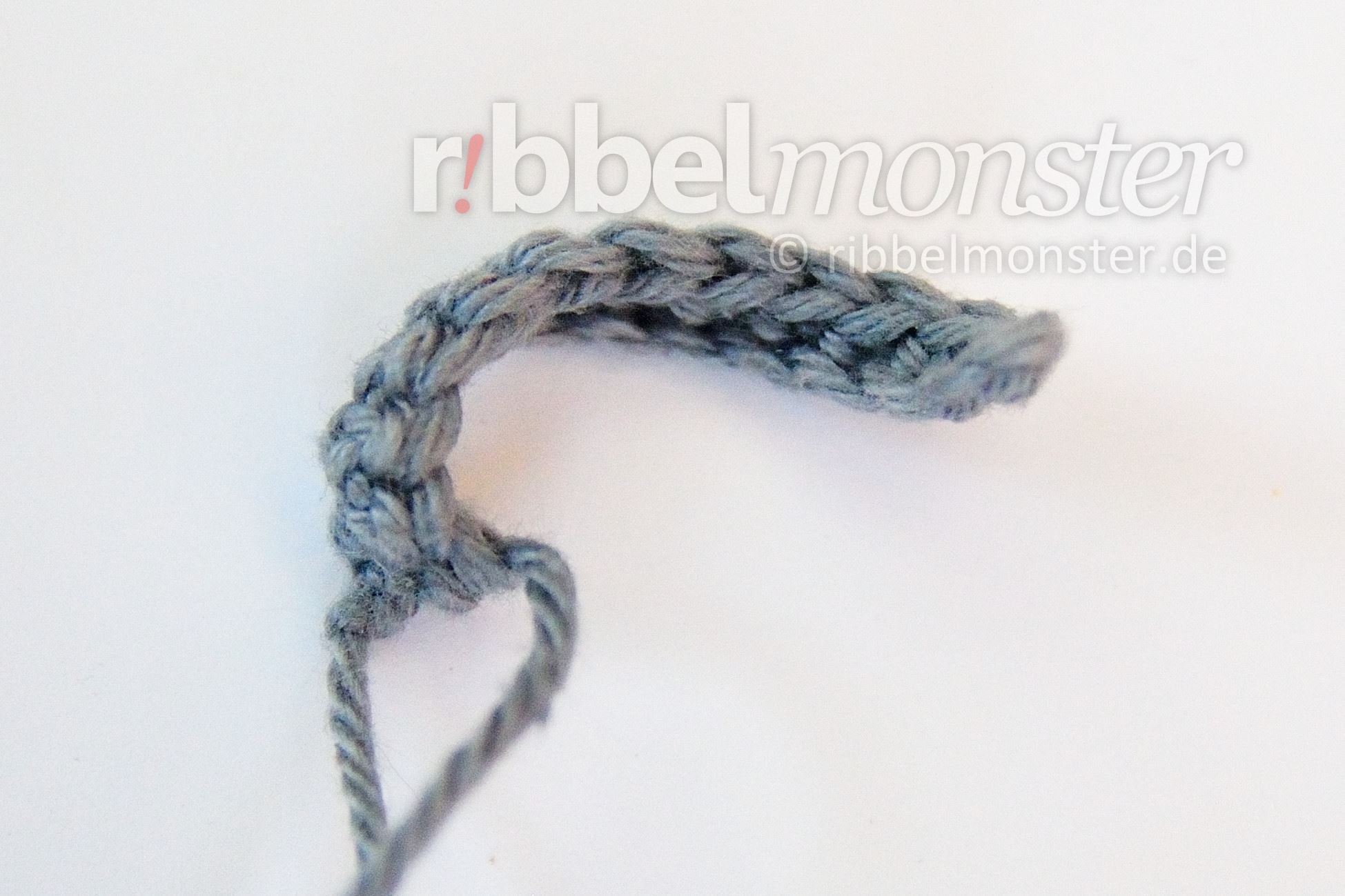
The tail for the Crochet Rhino is worked in just 2 rows from the base to the tip and back. Later, the tail will be tied to the rear of the rhinoceros using the two yarn ends.
- grey:
- 1st row:
- 12 chain stitches
- 1 turning chain stitch
- = 12 stitches
- 2nd row:
- every stitch one double crochet stitch (UK!)
- = 12 stitches
- cut yarn generously, pull through loop, do NOT cut the yarn end, it will be used later for sewing
Arms for Crochet Rhino (2x)
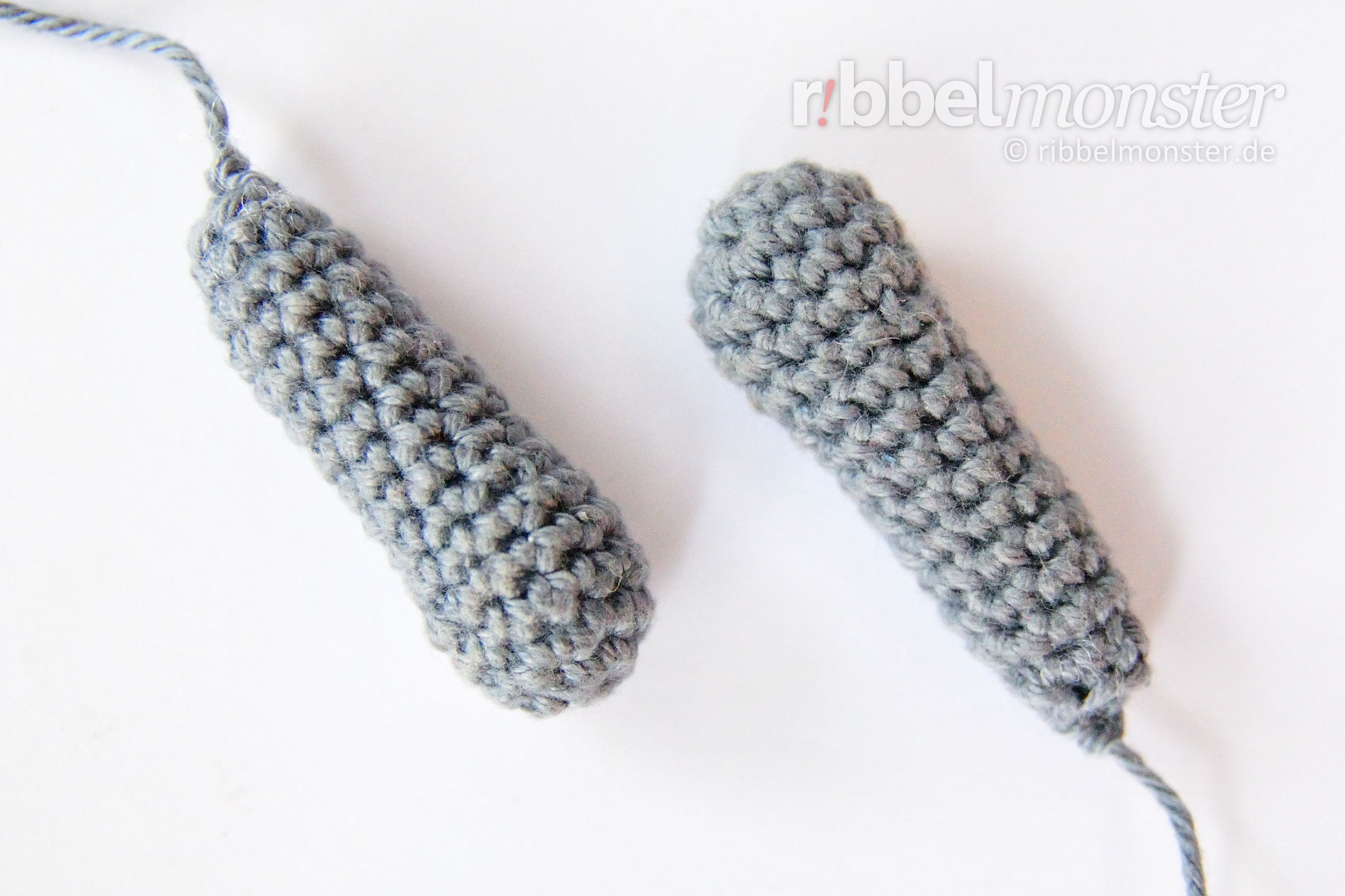
The arms for the Crochet Rhino are worked from the fingertips to the shoulders in spiral rounds using only double crochet stitches (UK!). Less filling is used in the front part to create nice flat palms.
Note! If you want to achieve a particularly beautiful result, you can hide regular increases and decreases by offsetting them a little. You can recognize regular increases by the phrase “double every … stitch,” and regular decreases by the phrase “crochet together every … and … stitch”. The stitch chart for spheres and circles might also be helpful for you. Additionally, you can apply a special crochet technique here for invisible decreases.
Note! If you want to create several nearly identical parts, it’s advisable to work on them consecutively on the same day. For larger parts, it’s even recommended to work on them simultaneously in stages. Our tension and tightness can vary from day to day, leading to visible differences.
- grey:
- 1st round:
- magic ring
- into the magic ring:
- 6 double crochet stitches (UK!)
- = 6 stitches
- 2nd round:
- double every stitch
- = 12 stitches
- 3rd – 5th round:
- (= 3 rounds)
- every stitch one stitch
- = 12 stitches
- 6th round:
- crochet together every 3rd and 4th stitch
- = 9 stitches
- 7th – 14th round:
- (= 8 rounds)
- every stitch one stitch
- = 9 stitches
- fill and stuff completely
- 15th round:
- crochet together every 2nd and 3rd stitch
- = 6 stitches
- cut yarn generously, pull through loop, do NOT cut the yarn end, it will be used later for sewing
Legs for Crochet Rhino (2x)
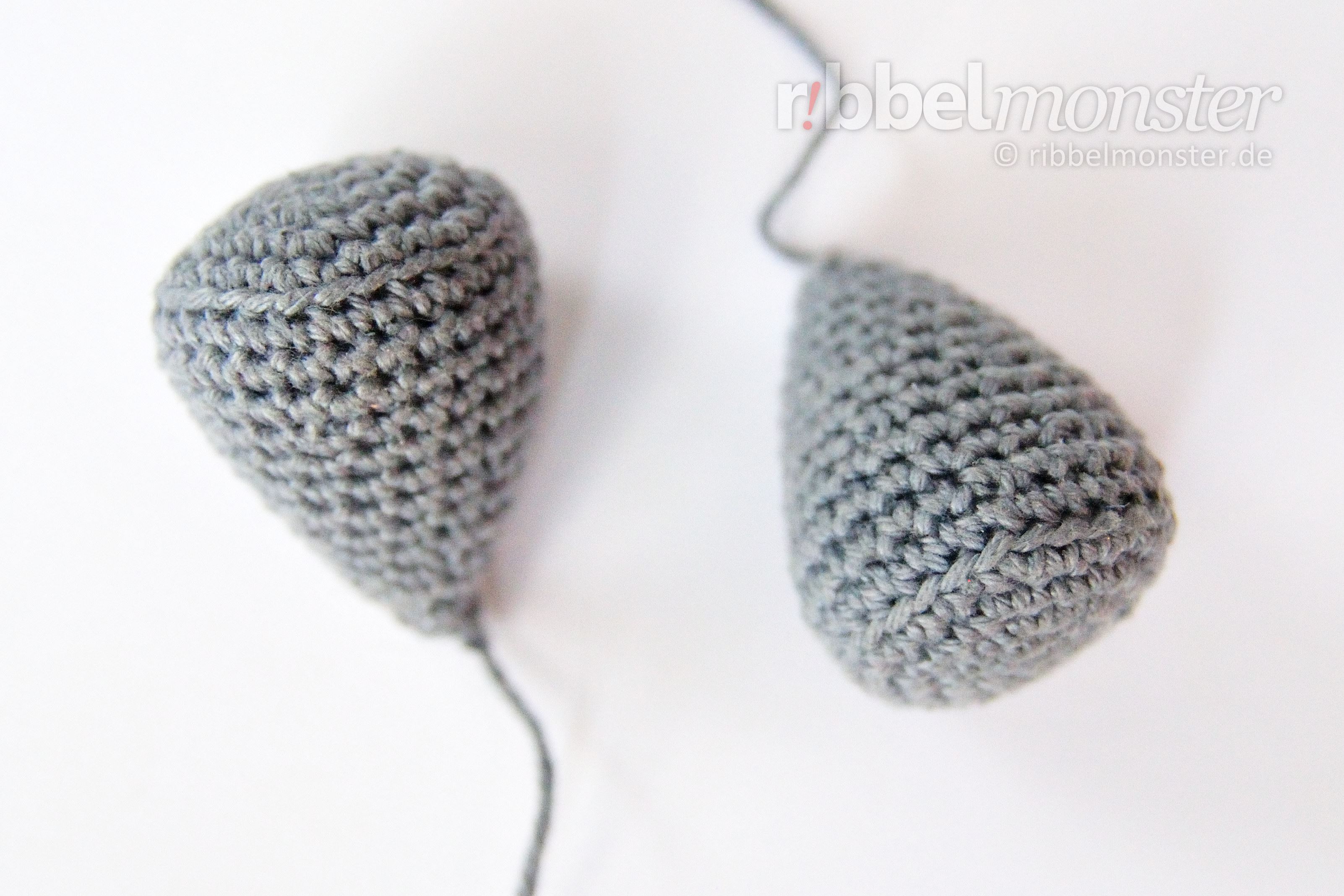
The legs for the Crochet Rhino are worked from the toes to the hips in spiral rounds using only double crochet stitches (UK!). The lower part is filled neatly, while the upper part remains a bit looser for better movement later on.
Note! If you want to achieve a particularly beautiful result, you can hide regular increases and decreases by offsetting them a little. You can recognize regular increases by the phrase “double every … stitch,” and regular decreases by the phrase “crochet together every … and … stitch”. The stitch chart for spheres and circles might also be helpful for you. Additionally, you can apply a special crochet technique here for invisible decreases.
Note! If you want to create several nearly identical parts, it’s advisable to work on them consecutively on the same day. For larger parts, it’s even recommended to work on them simultaneously in stages. Our tension and tightness can vary from day to day, leading to visible differences.
- grey:
- 1st round:
- magic ring
- into the magic ring:
- 6 double crochet stitches (UK!)
- = 6 stitches
- 2nd round:
- double every stitch
- = 12 stitches
- 3rd round:
- double every 2nd stitch
- = 18 stitches
- 4th round:
- double every 3rd stitch
- = 24 stitches
- 5th round:
- double every 4th stitch
- = 30 stitches
- 6th round:
- into the back loop only:
- every stitch one stitch
- = 30 stitches
- into the back loop only:
- 7th round:
- crochet together every 14th and 15th stitch
- = 28 stitches
- 8th round:
- crochet together every 13th and 14th stitch
- = 26 stitches
- 9th round:
- crochet together every 12th and 13th stitch
- = 24 stitches
- 10th round:
- crochet together every 11th and 12th stitch
- = 22 stitches
- 11th round:
- crochet together every 10th and 11th stitch
- = 20 stitches
- 12th round:
- crochet together every 9th and 10th stitch
- = 18 stitches
- 13th round:
- crochet together every 8th and 9th stitch
- = 16 stitches
- 14th round:
- crochet together every 7th and 8th stitch
- = 14 stitches
- 15th round:
- crochet together every 6th and 7th stitch
- = 12 stitches
- 16th round:
- every stitch one stitch
- = 12 stitches
- fill and stuff completely
- 17th round:
- crochet together every 1st and 2nd stitch
- = 6 stitches
- cut yarn generously, pull through loop, do NOT cut the yarn end, it will be used later for sewing
Horn for Crochet Rhino (1x)
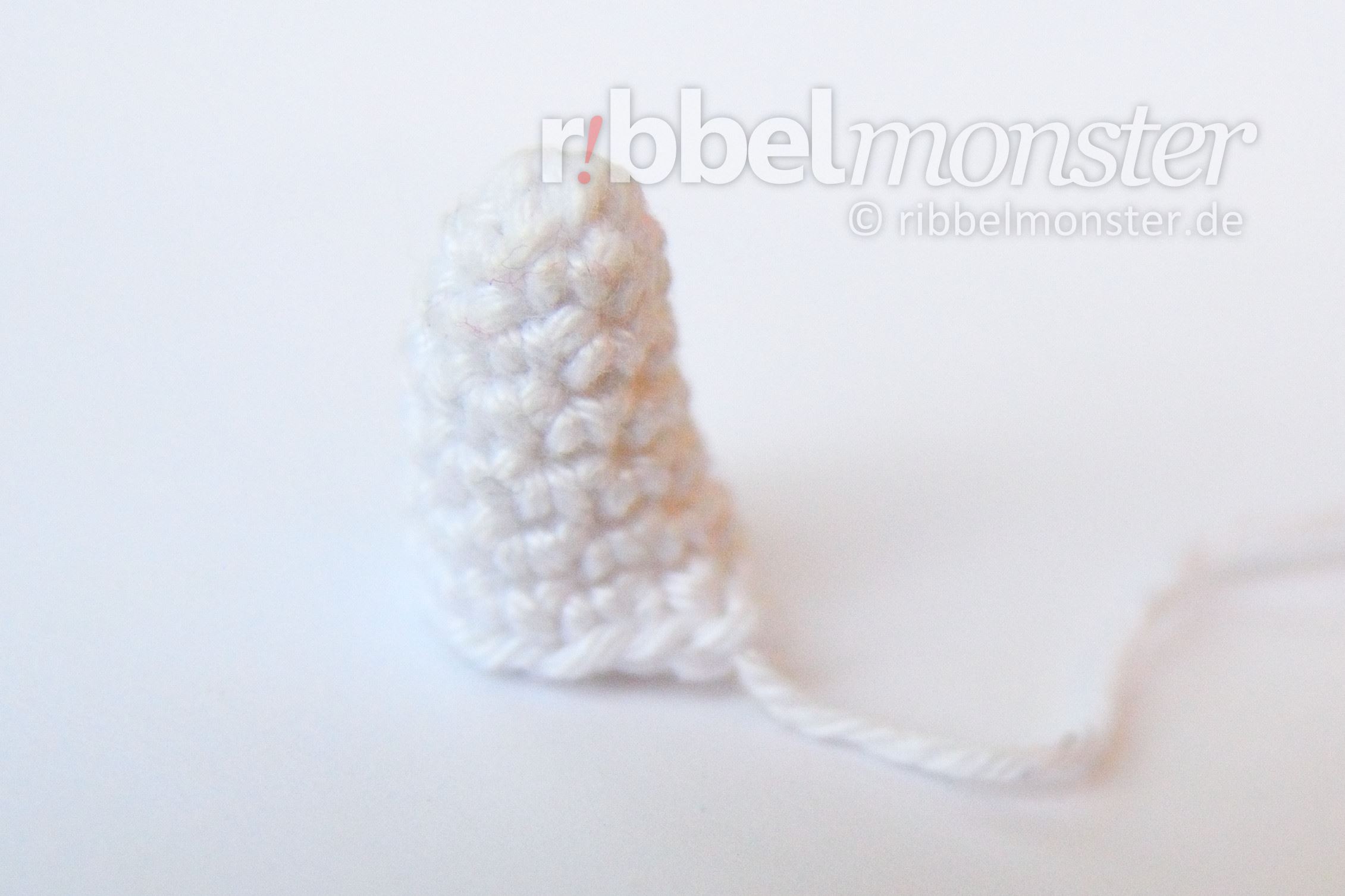
Now we just need to make the horn for the Crochet Rhino. We start at the tip and crochet downward in spiral rounds using only double crochet stitches (UK!). The horn will be sewn all around the snout with the yarn end later.
Tip: Wenn du ein besonders schönes Ergebnis erhalten möchtest, kannst du die regelmäßigen Zunahmen durch Versetzen ein wenig verstecken. Dazu verwendest du einfach die Maschentabelle für Kugeln und Kreise.
(Redaktion: Block ersetzen)
- white:
- 1st round:
- magic ring
- into the magic ring:
- 6 double crochet stitches (UK!)
- = 6 stitches
- 2nd round:
- double every 6th stitch
- = 7 stitches
- 3rd round:
- double every 7th stitch
- = 8 stitches
- 4th round:
- double every 8th stitch
- = 9 stitches
- 5th round:
- double every 9th stitch
- = 10 stitches
- 6th round:
- double every 10th stitch
- = 11 stitches
- 7th round:
- double every 11th stitch
- = 12 stitches
- beyond the end of the round:
- 1x one slip stitch into one stitch
- cut yarn generously, pull through loop, do NOT cut the yarn end, it will be used later for sewing
Rhino Finish
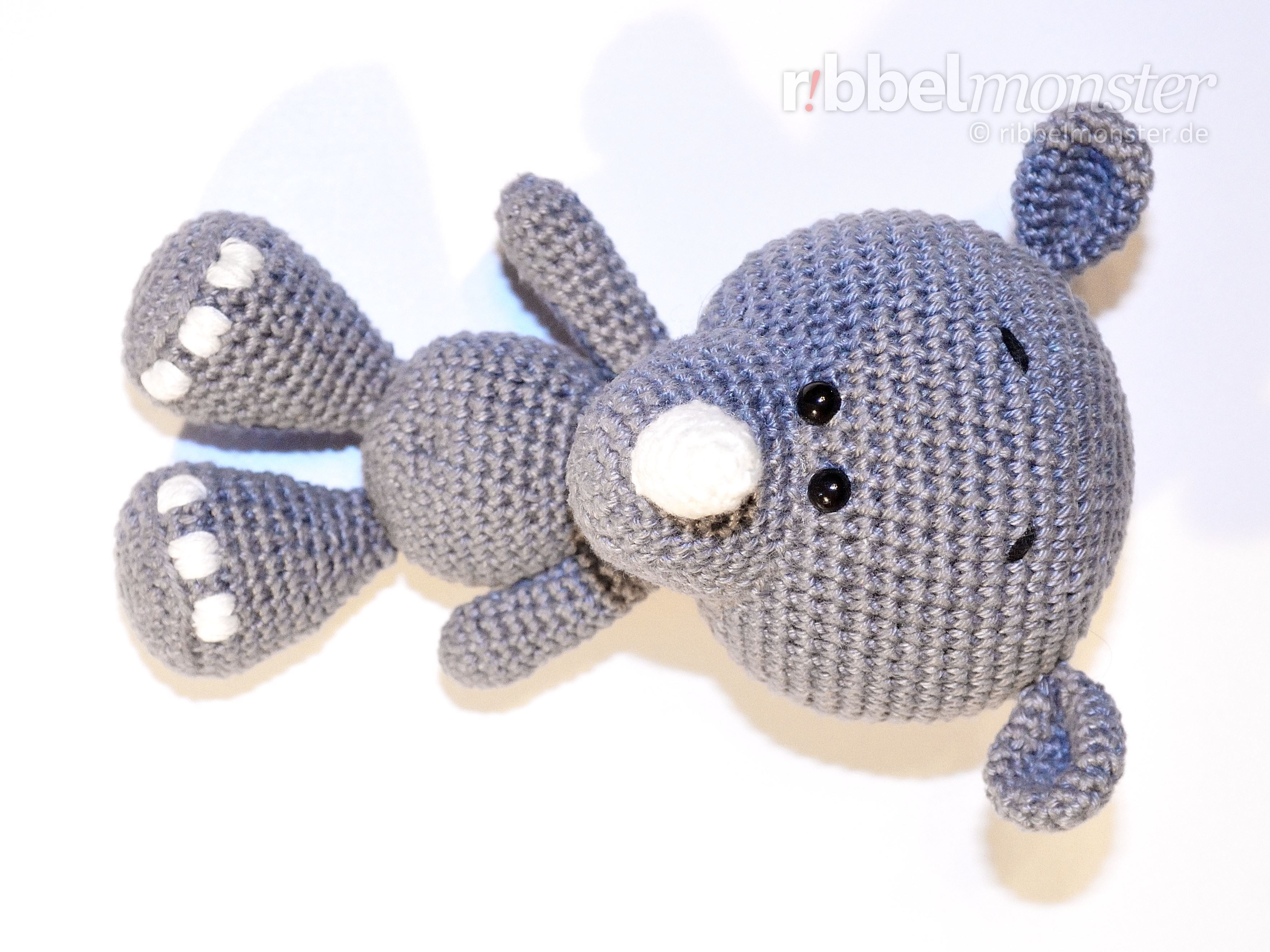
After you have crocheted all the parts, the puzzle can be completed. Before you start, be sure to pin the crocheted rhinoceros together with pins to find the right positions. This makes sewing it together easier, and you can make corrections easily.
Sew Head to Body
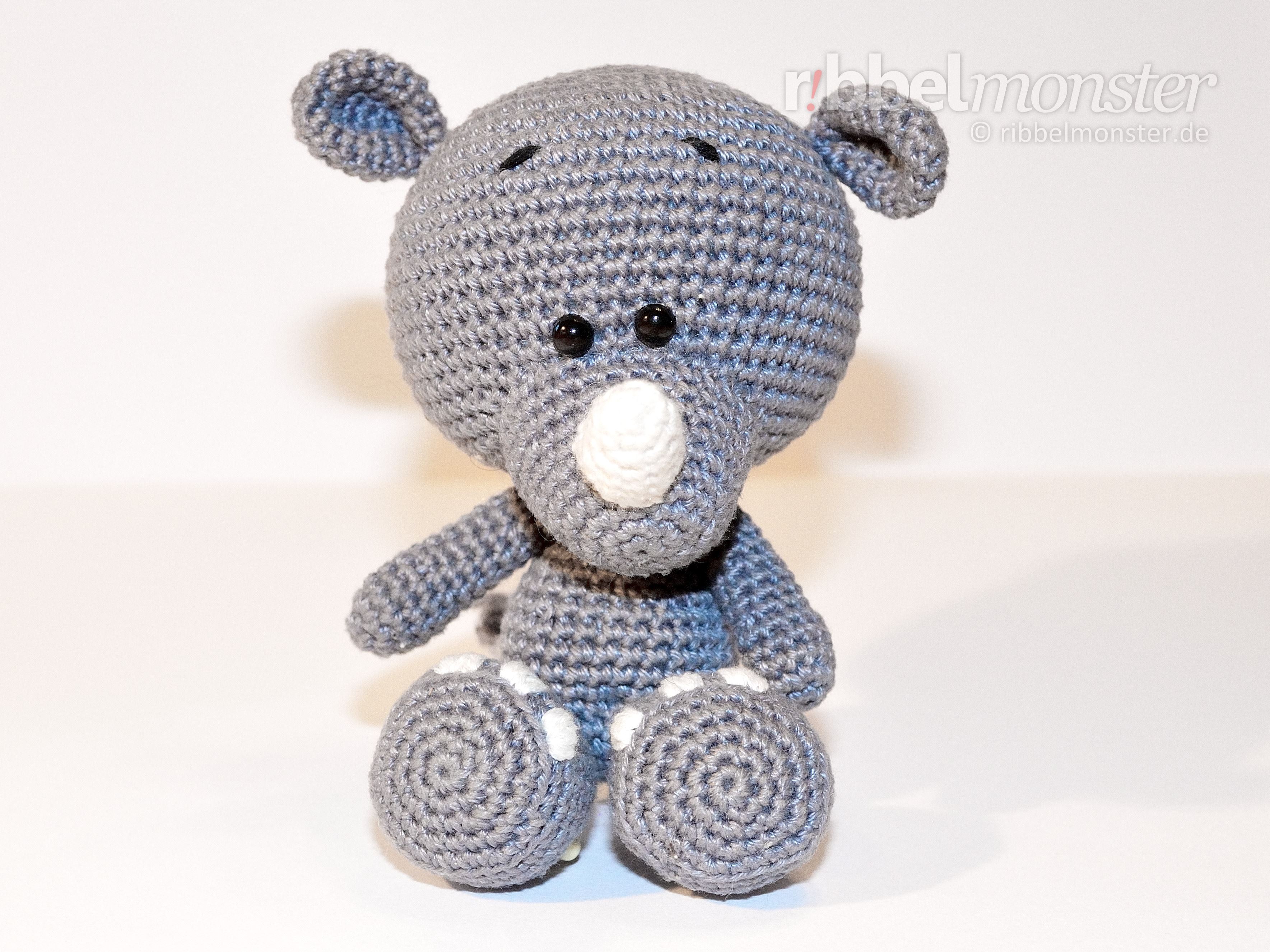
First, sew head and body together with the openings facing each other. Use the long yarn end from the head and work around the two openings. If you have never done this before, the pattern for sewing together open parts might help.
Sew Snout to Head
Now you can sew the snout all around with the yarn end. It is very helpful if it is first pinned with pins, and you gradually remove them. Just before completing the round, fill and stuff the snout well.
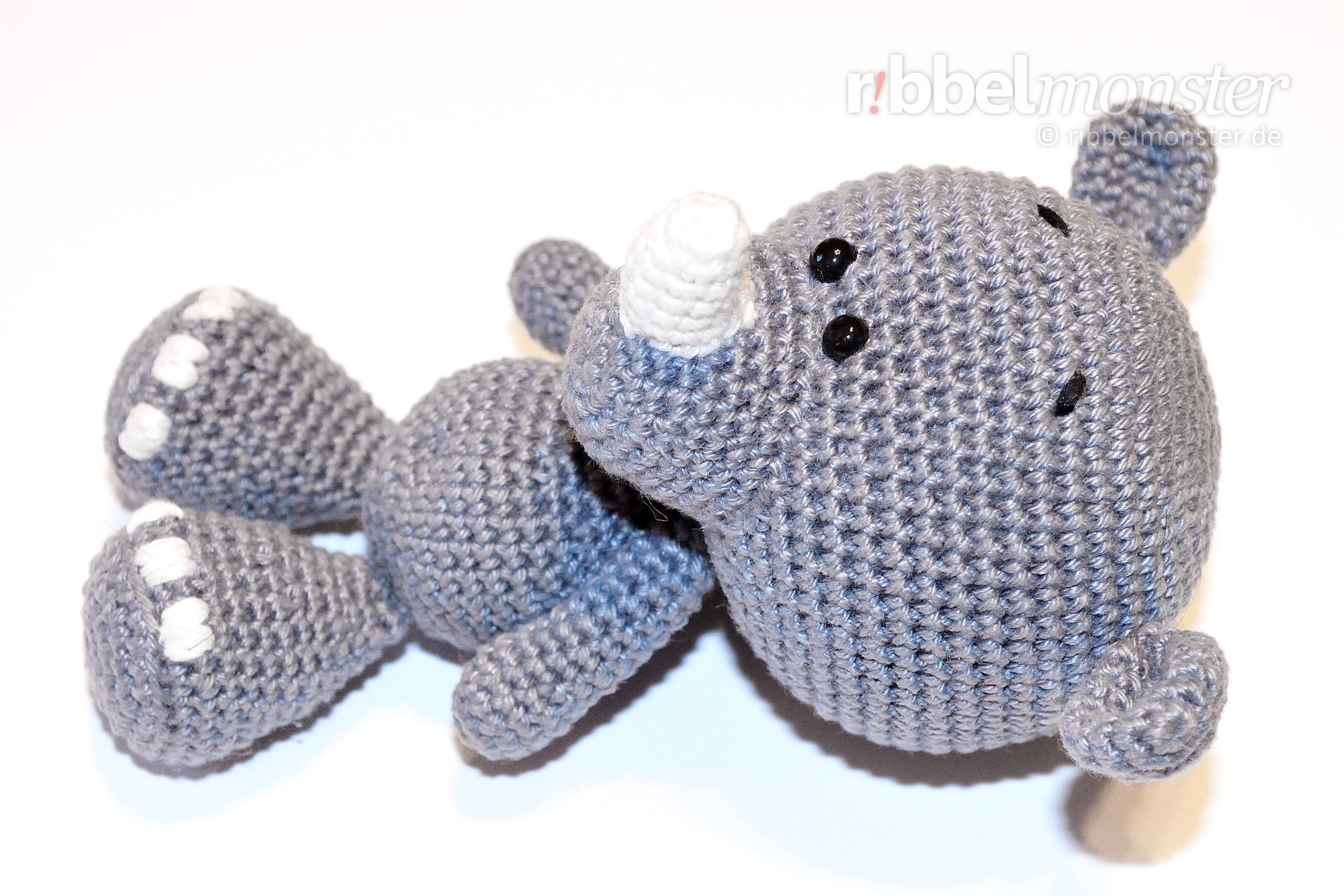
Sew Horn to Nose
Next, place the horn exactly in the middle of the nose and sew it all around. You can also use the remaining yarn end, and just before completing the round, fill and stuff the horn well.
Sew Ears to Head
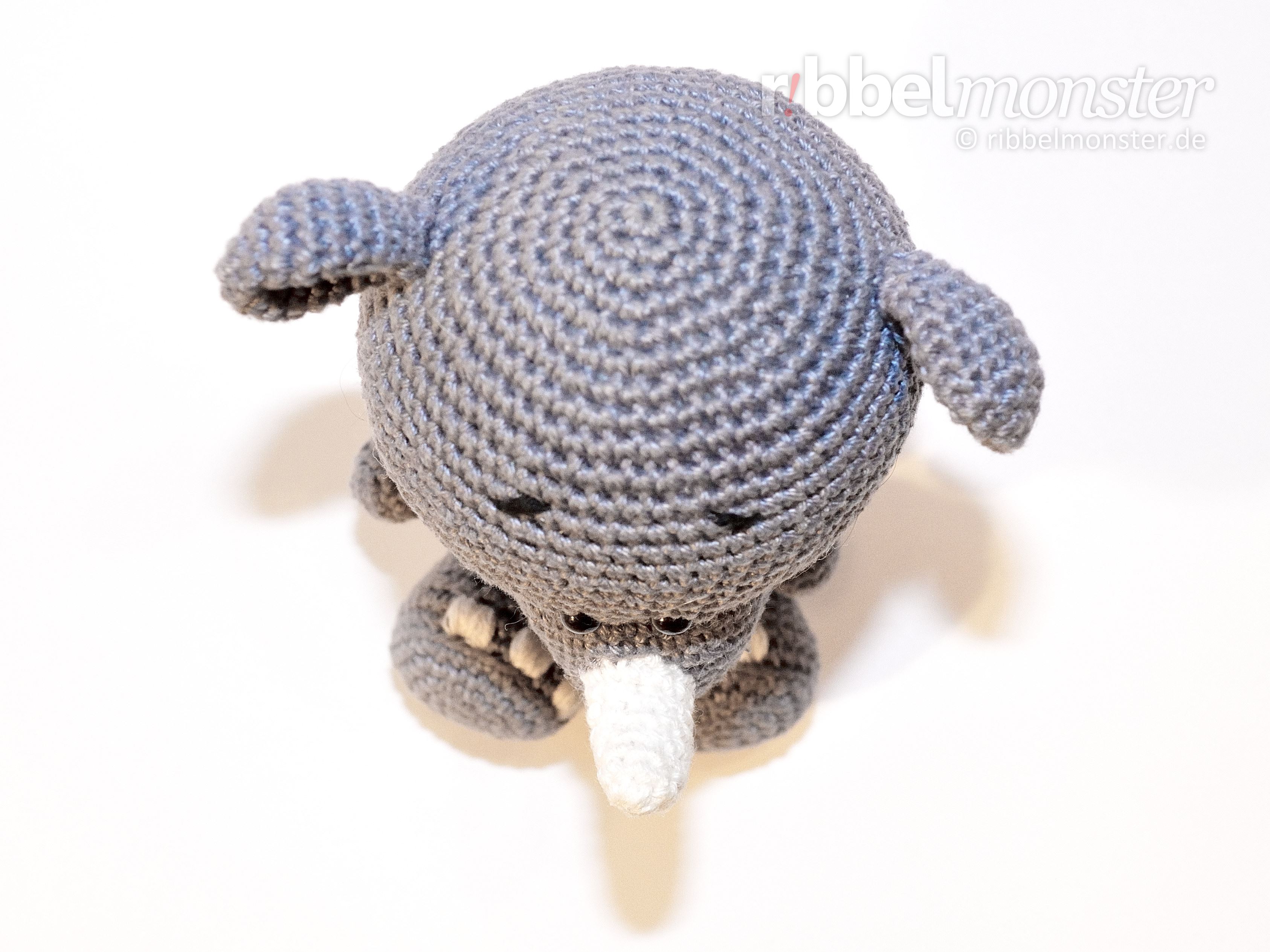
Then sew the ears onto the head. They are not filled, only folded flat. The open side
Sew Arms and Legs
Next, you can sew the arms just below the head. Either horizontally flat folded or articulated with thread joints, as described in the pattern for thread joints.
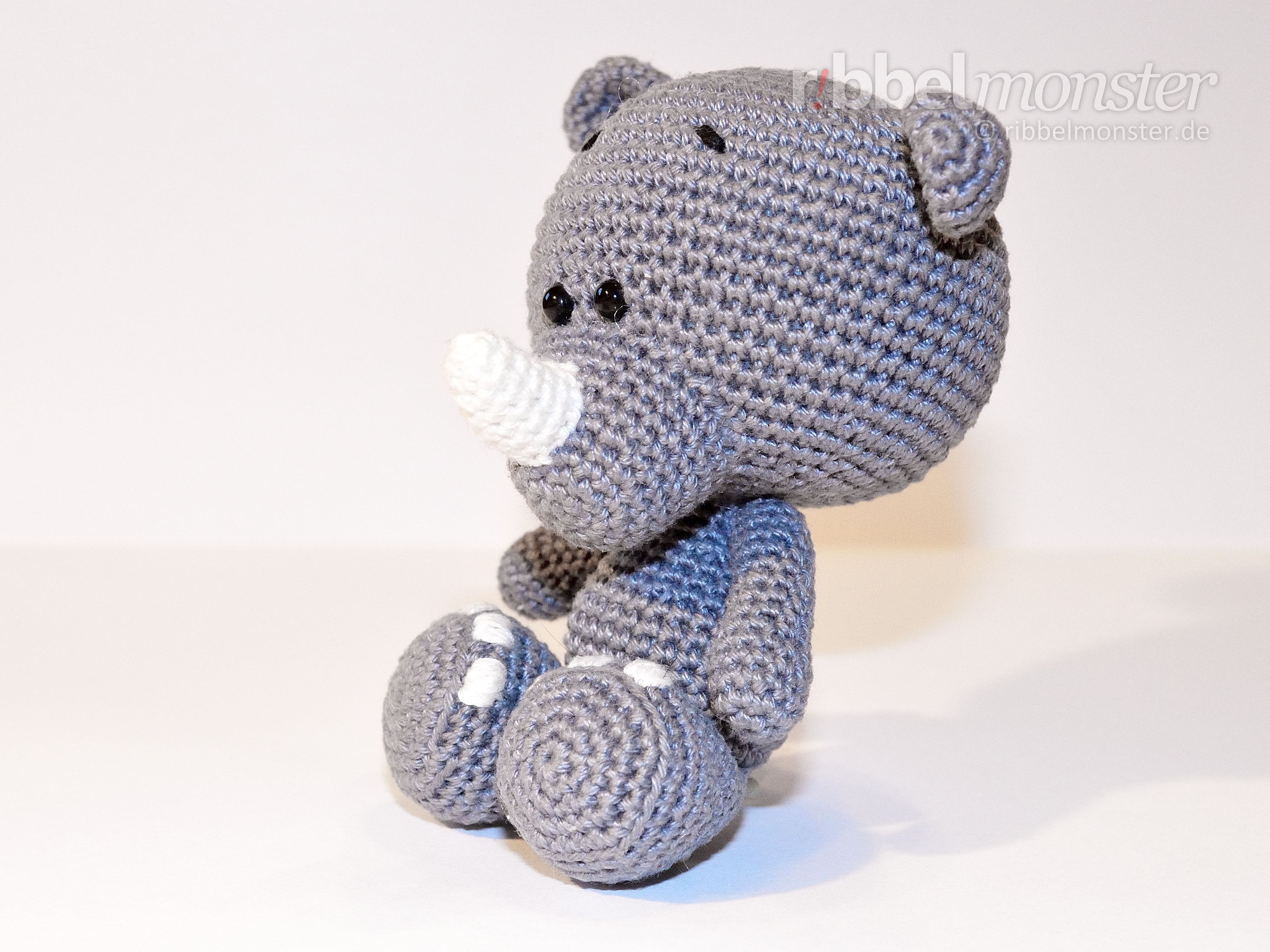
The legs are sewn horizontally folded to the center of the underside in a line.
Sew Tail
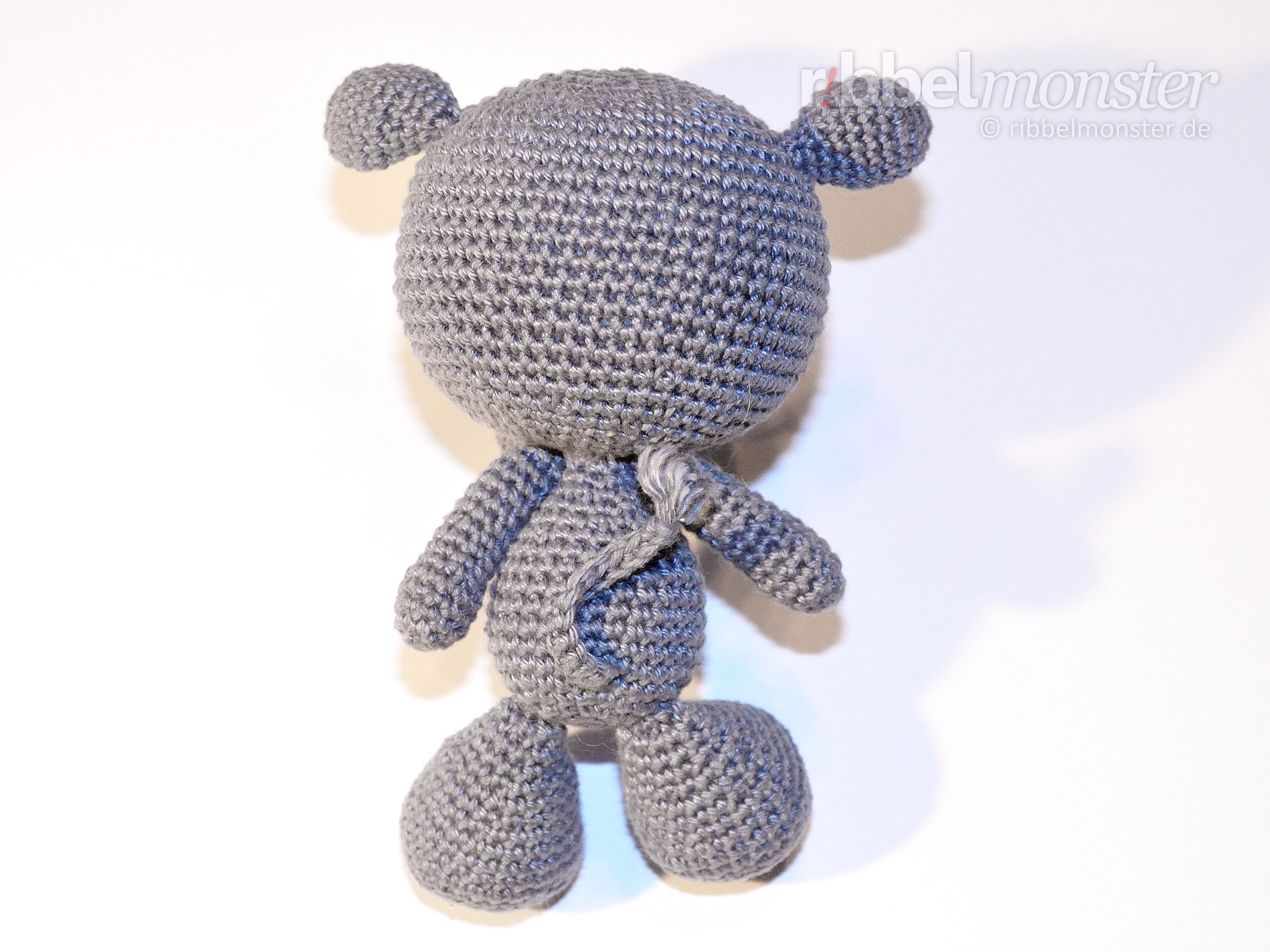
Now attach the tail to the center of the back, as you can read under attaching small parts. Use the yarn ends and tie it horizontally around the 6th round.
Embroider Eyebrows
Finally, embroider the eyebrows with black embroidery thread or stuffing yarn. They are positioned 7 and 8 rounds above the eyes, slanting upwards on the inside.
Shape Belly Button
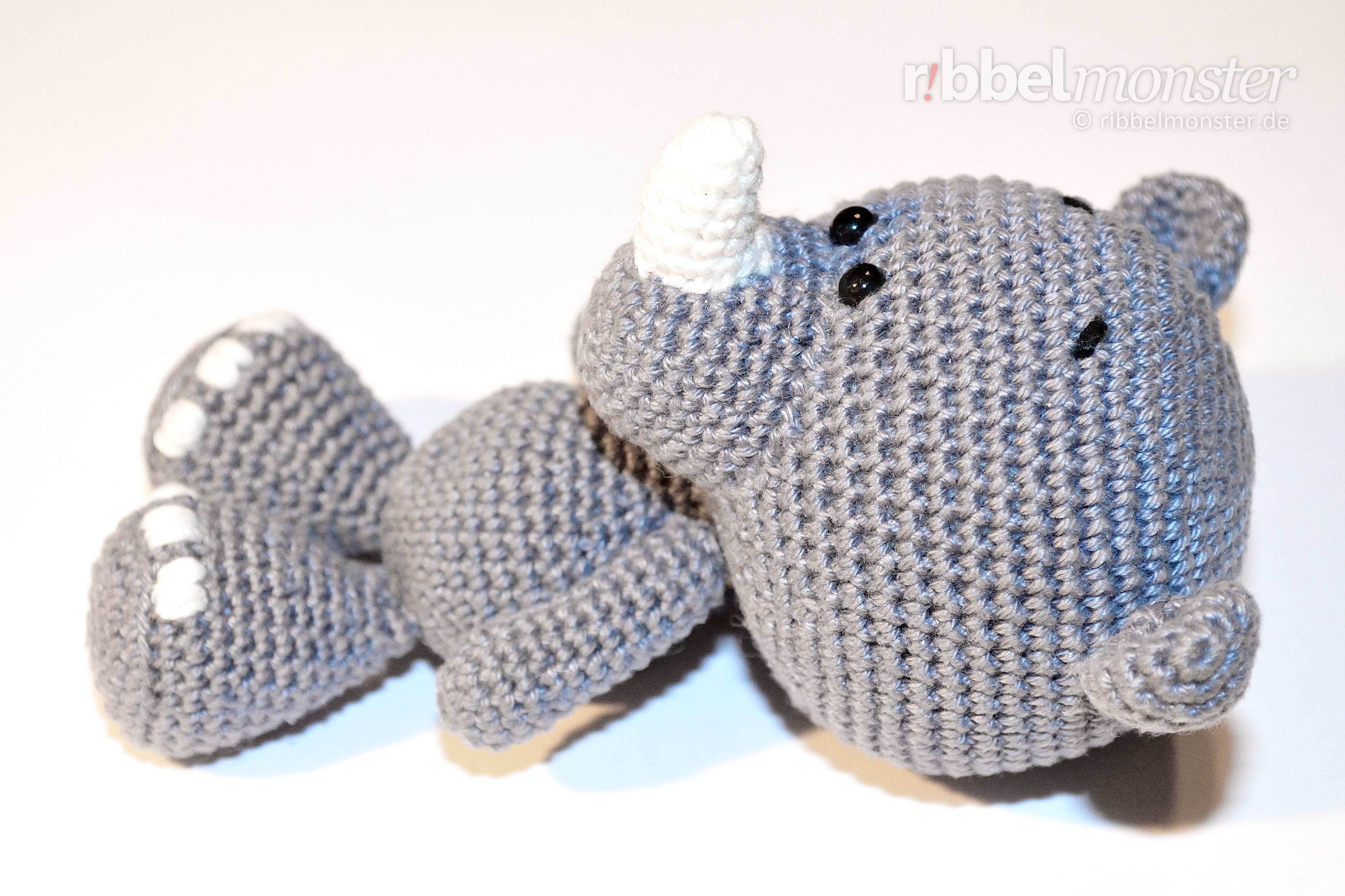
Afterward, use yarn color to shape the belly button. Horizontally stitch around two stitches at the appropriate location and pull them on the back around two stitches below the tail.
Embroider Toes
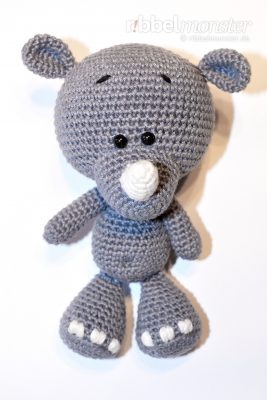
Then, each foot gets 3 toes, which you embroider with white stuffing yarn or embroidery thread. It’s easiest to start with the middle toe, stitching vertically over 2 rounds until the size and volume of the toe fit. Then, similarly, embroider a toe on each side, ensuring an even distance.
Done!
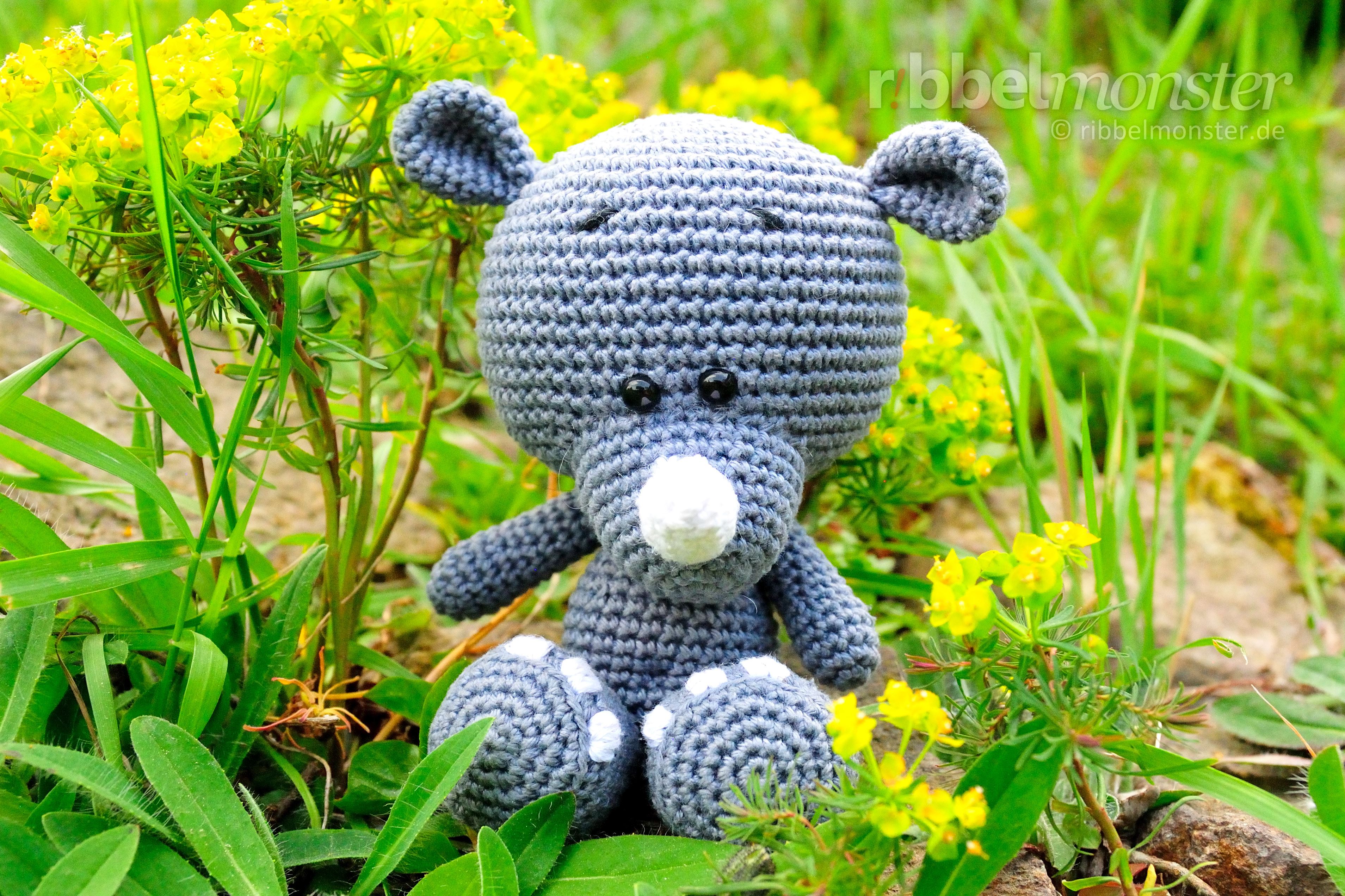
Now your rhinoceros is already finished! I hope you enjoyed it and look forward to your next visit!
Vielleicht hast du aber auch Lust die anderen Amigurumis der Naminja Serie nachzuarbeiten.
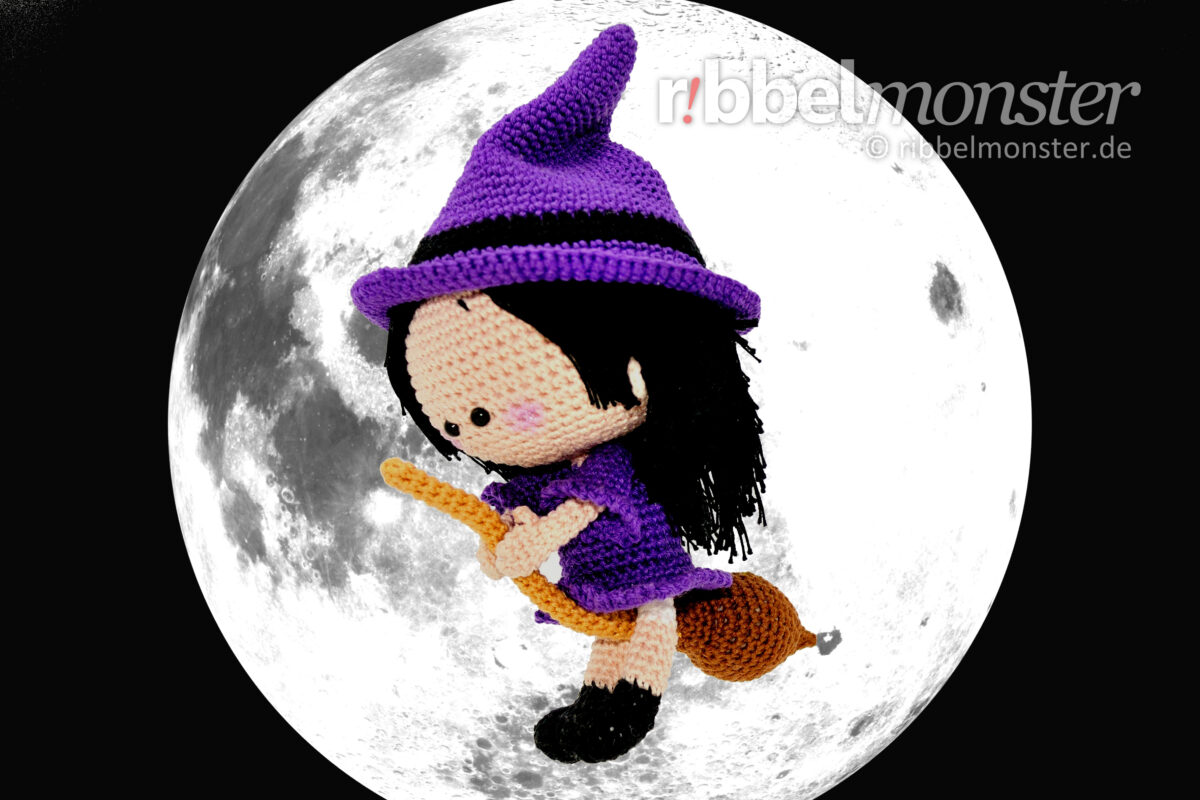
Schau mal wer gerda am Mond vorbei geflogen ist. Das ist die kleine Hexe Mechthild auf ihrem neuen Hexenbesen.
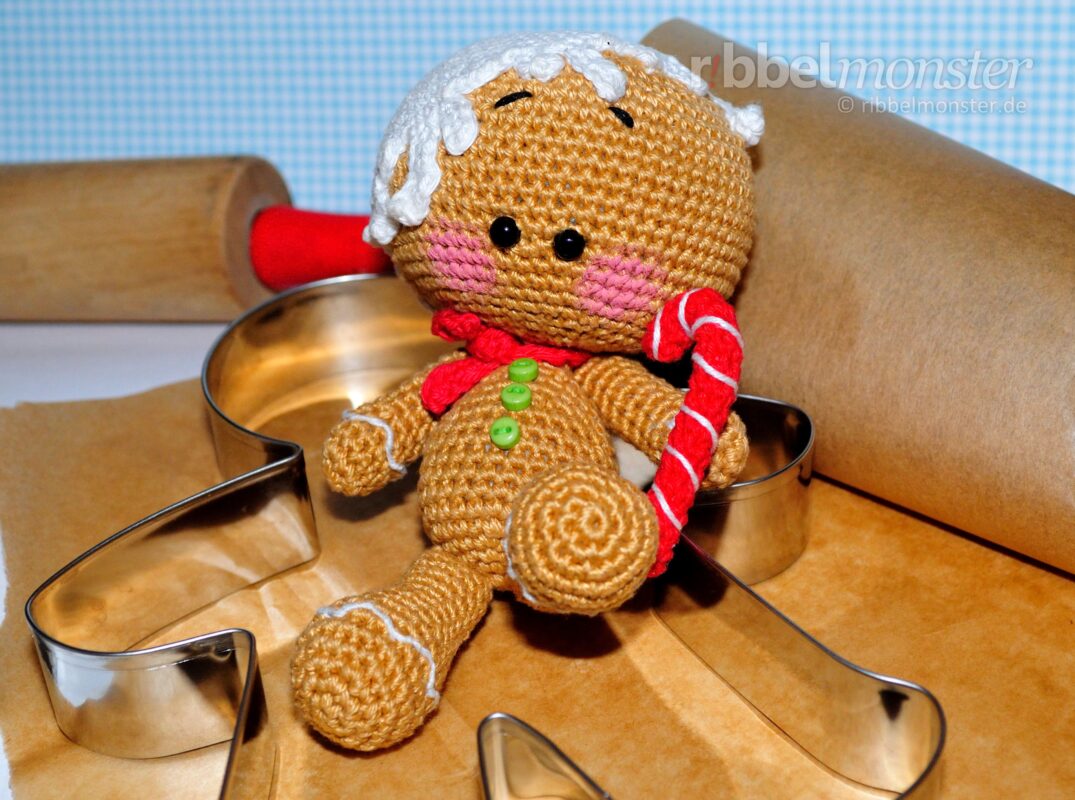
Wenn du Lust hast, können wir zusammen den zuckersüßen Lebkuchenmann Pepe häkeln.
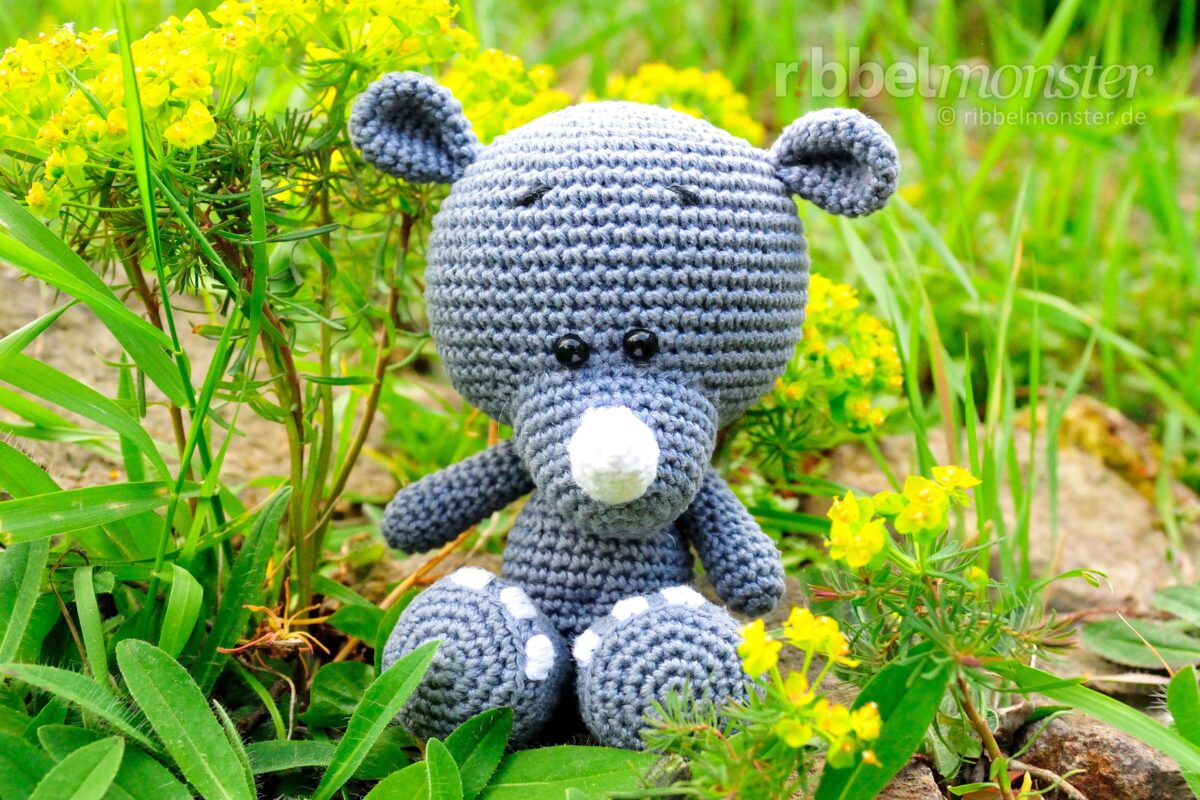
Am liebsten Mag das Nashorn Piko sonniges Wetter und saftige Wiesen.
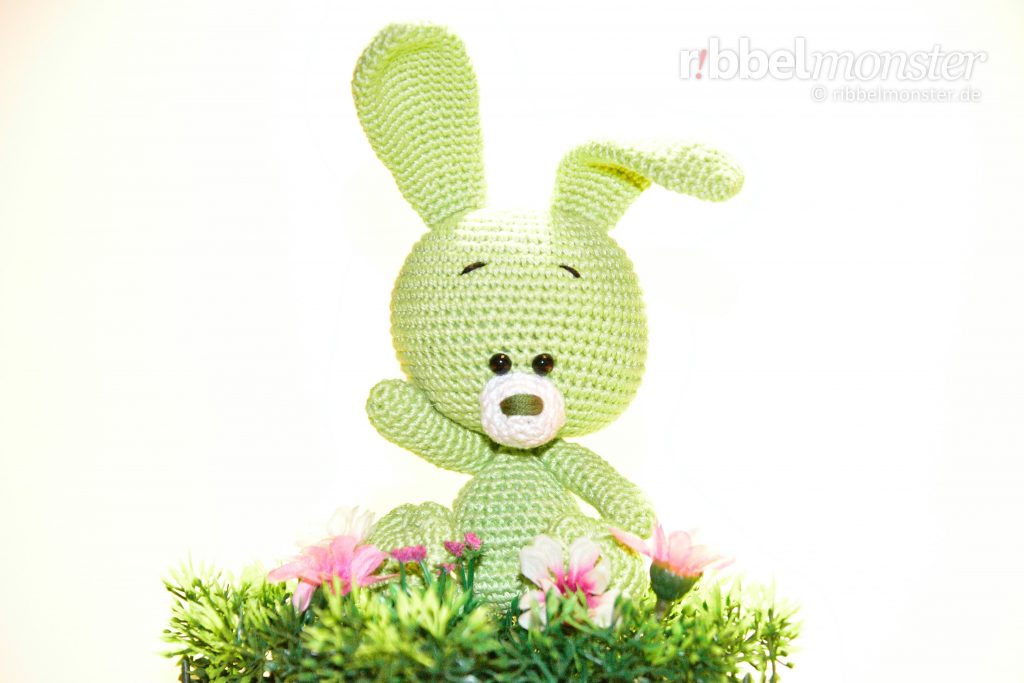
Schau mal wer da so eifrig winkt. Da sitzt doch Hase Ono mitten in der Blumenwiese.
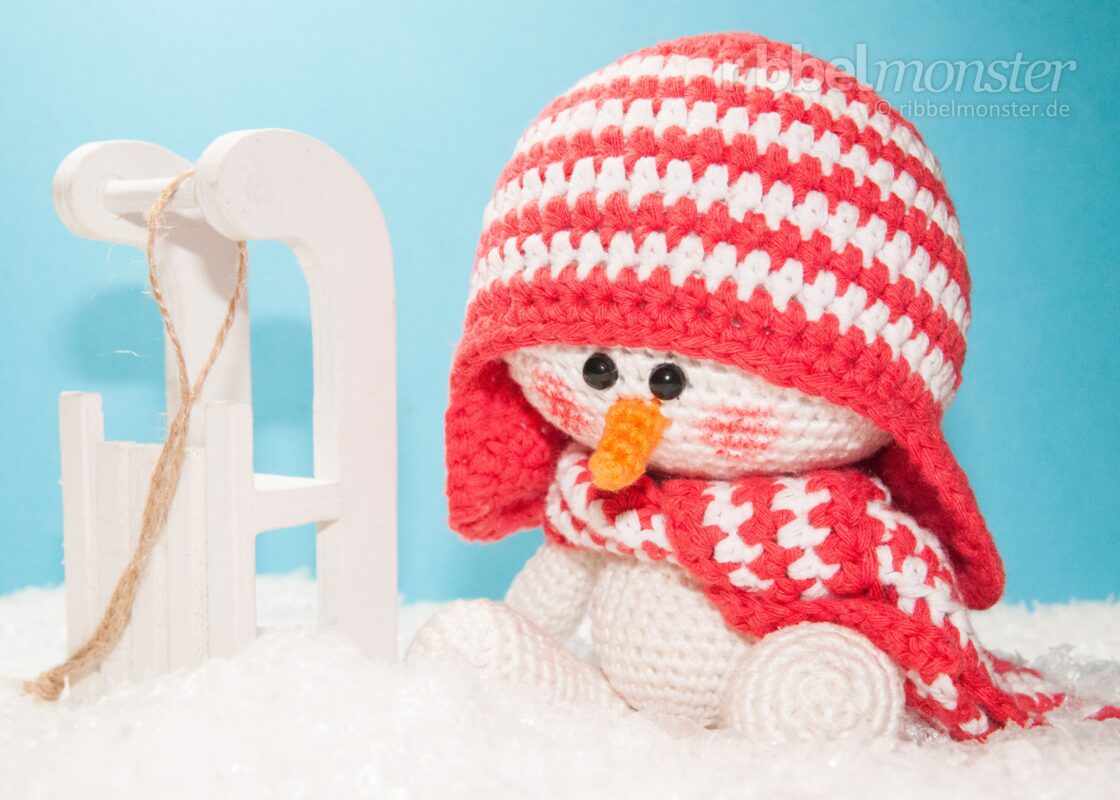
Der kleine Schneemann Sven sitzt schon den ganzen Tag mit seinem Schlitten am Fenster und wartet auf den ersten Schnee.
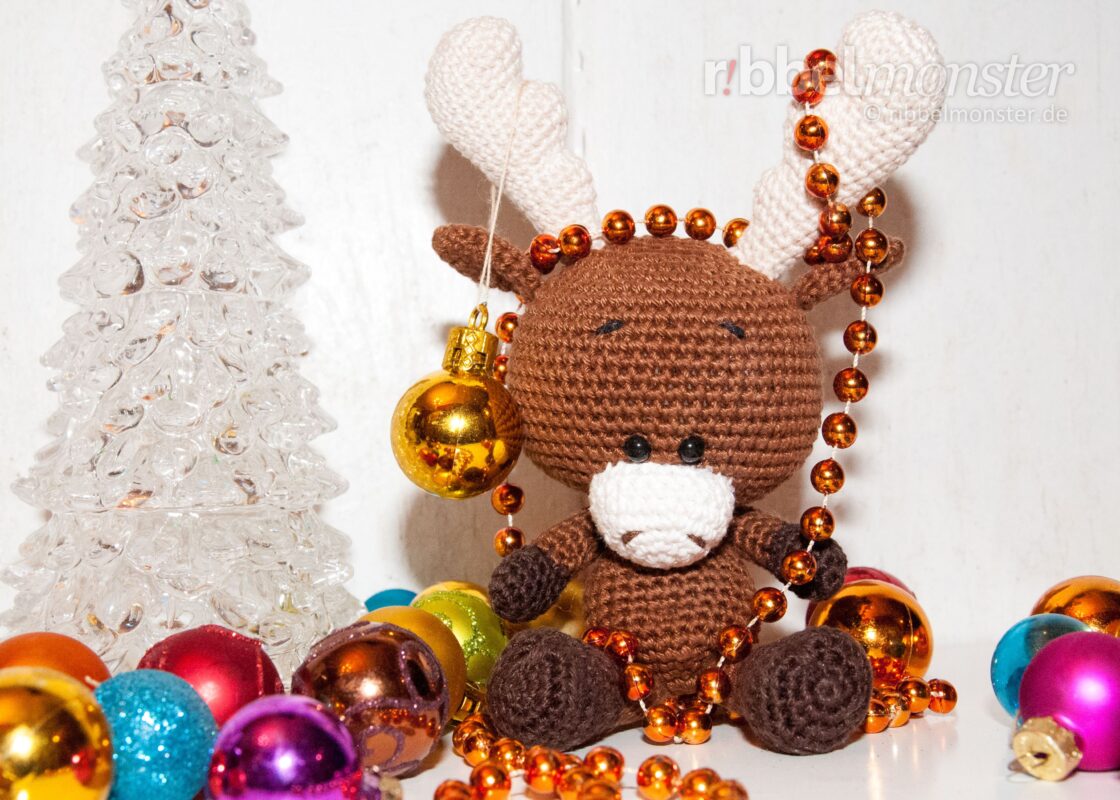
Ich fürchte unser Elch Sören hat sich schon wieder im Christbaumschmuck verheddert. Kannst du ihn retten?
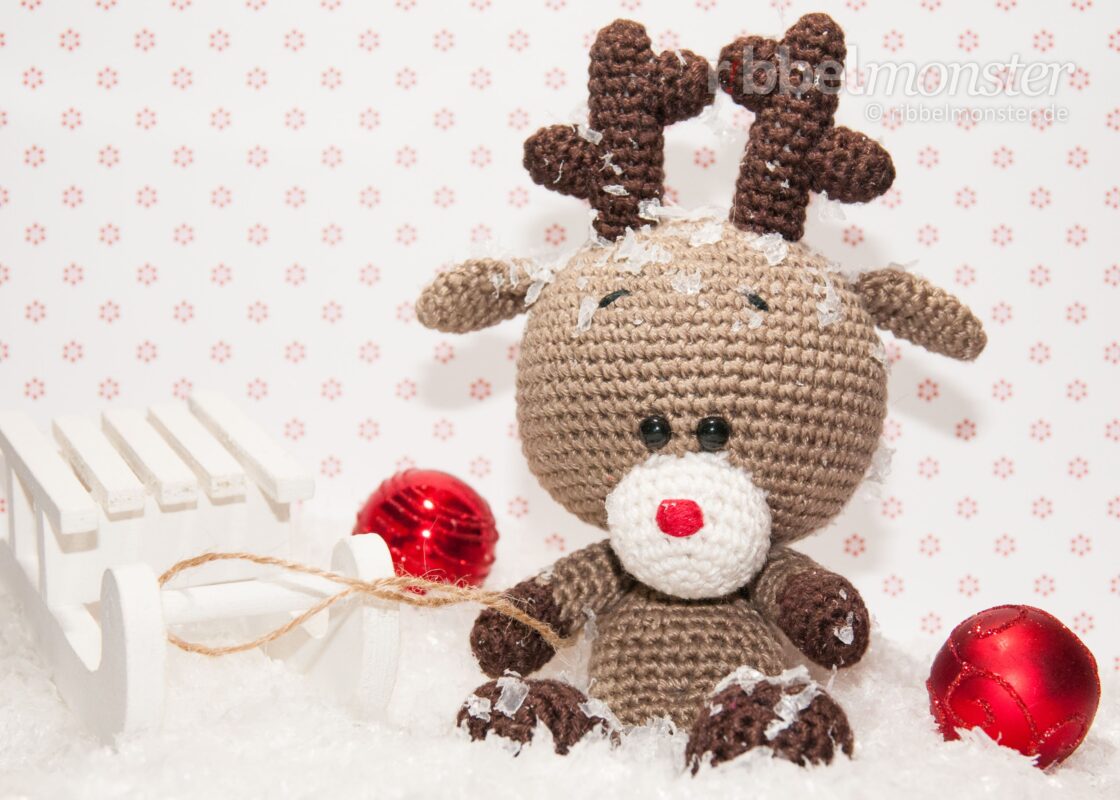
Es sieht ganz so aus, als hätte das Rentier Rudi schon den Schlitten bereit gemacht.
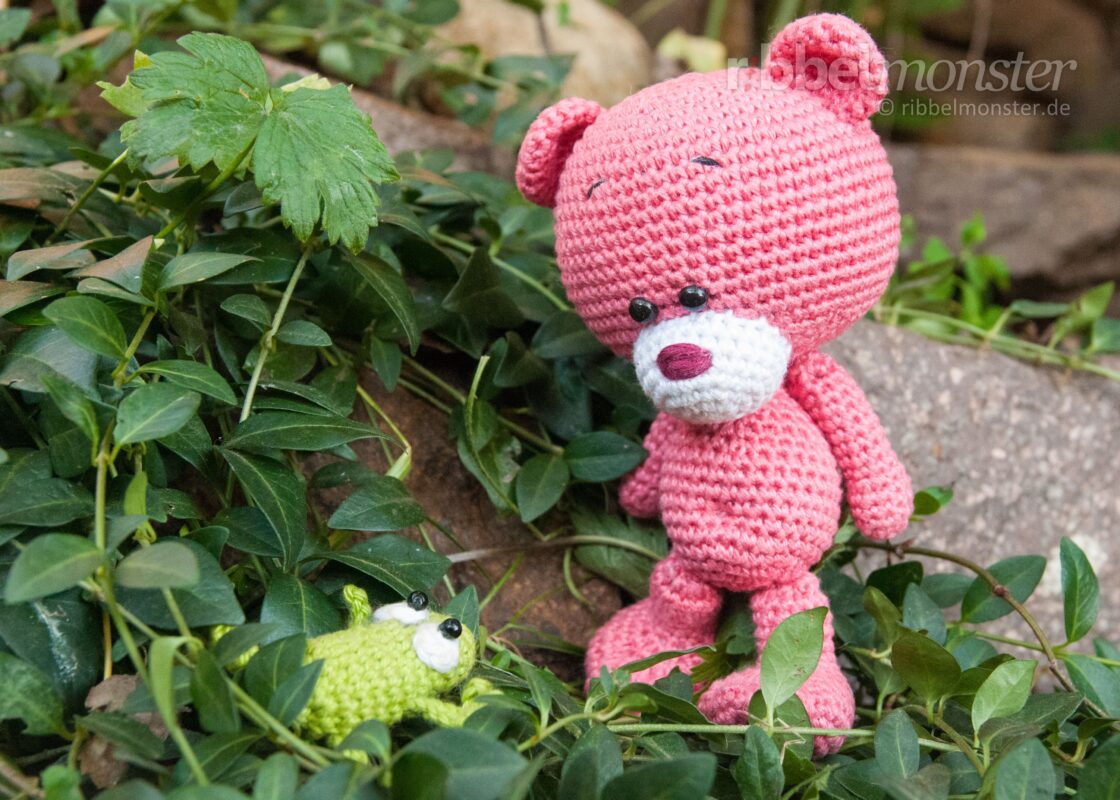
Ich glaube Teddy Pina hat sich gerade fürchterlich erschreckt. Weißt du was das ist?

